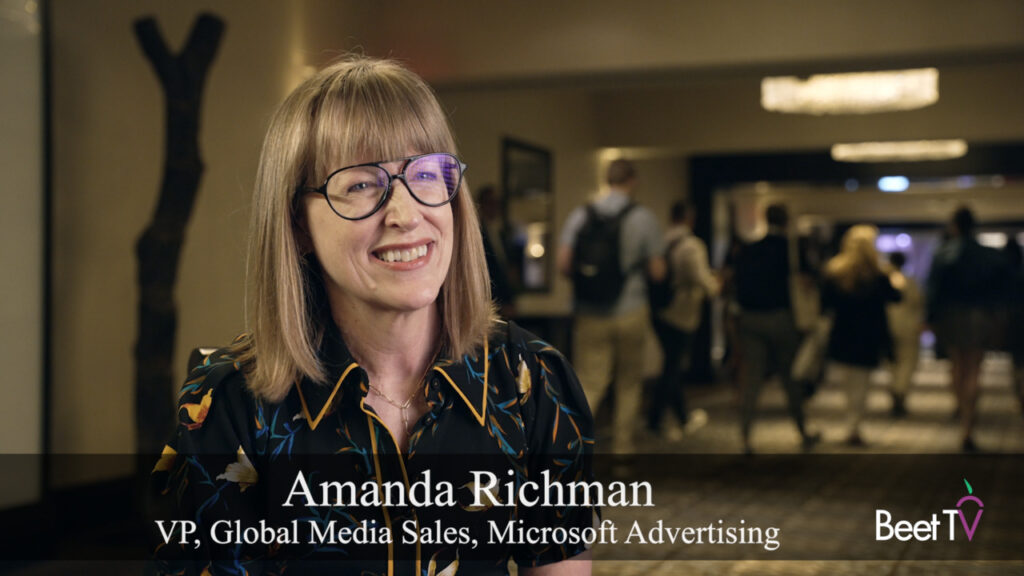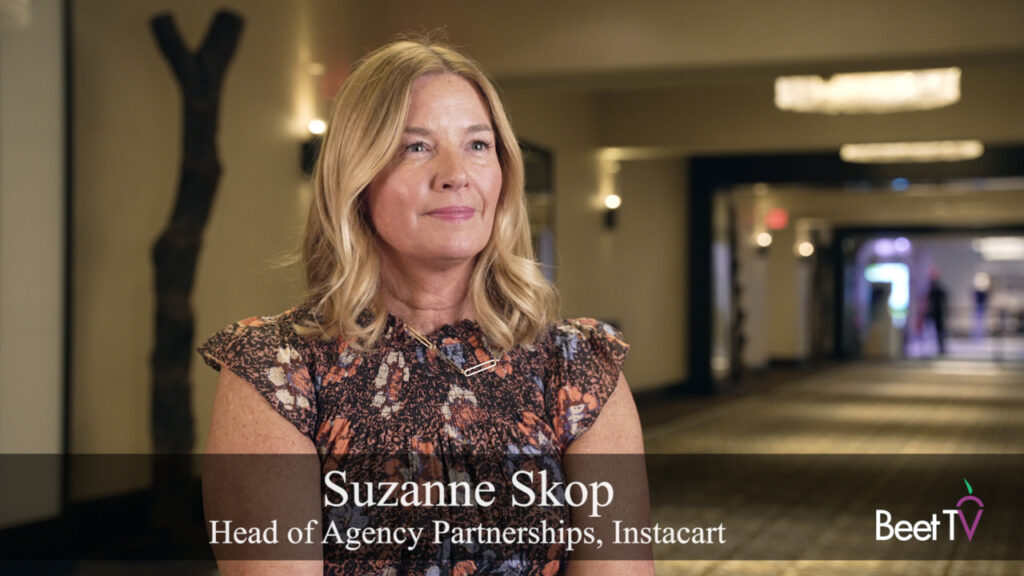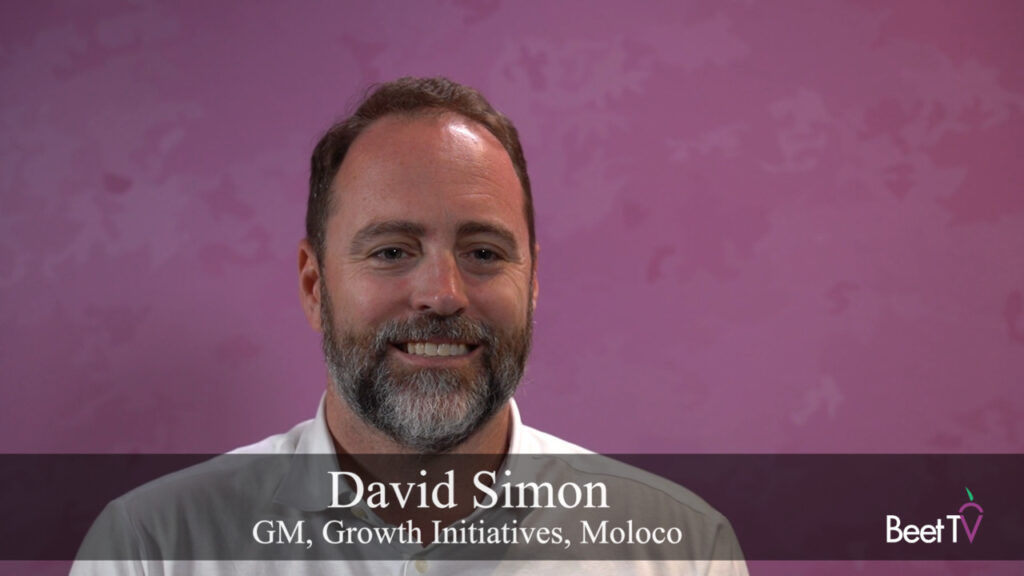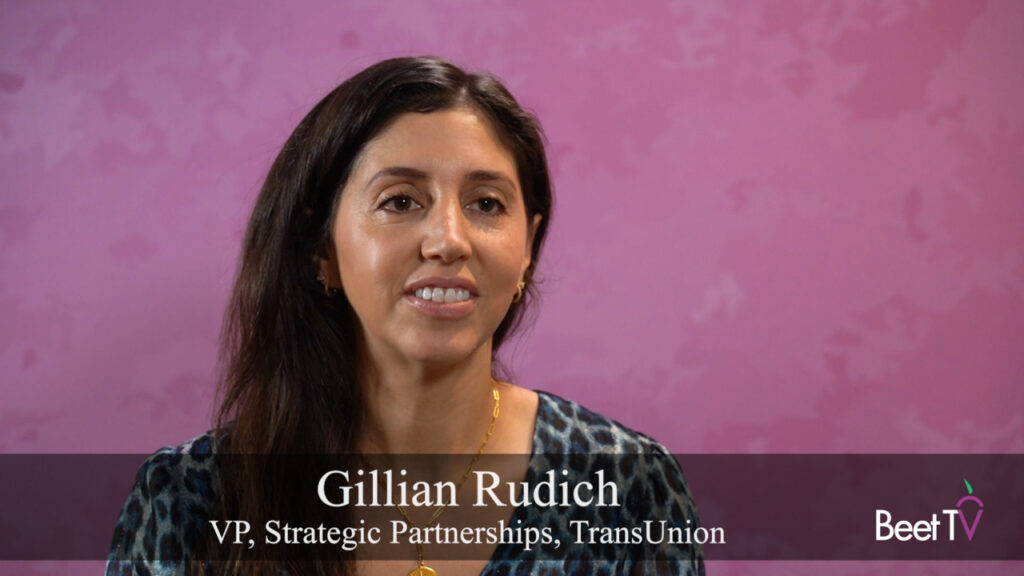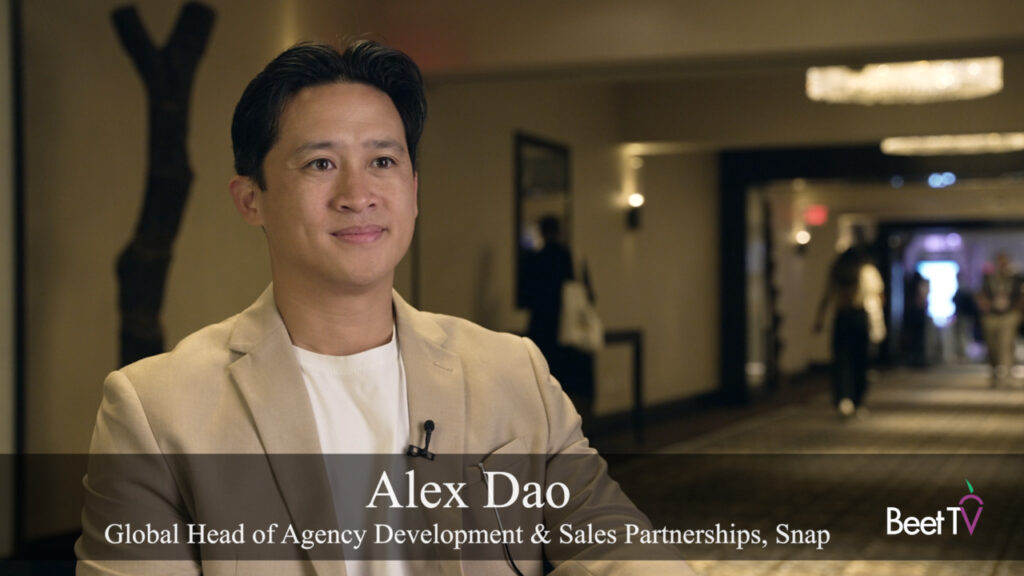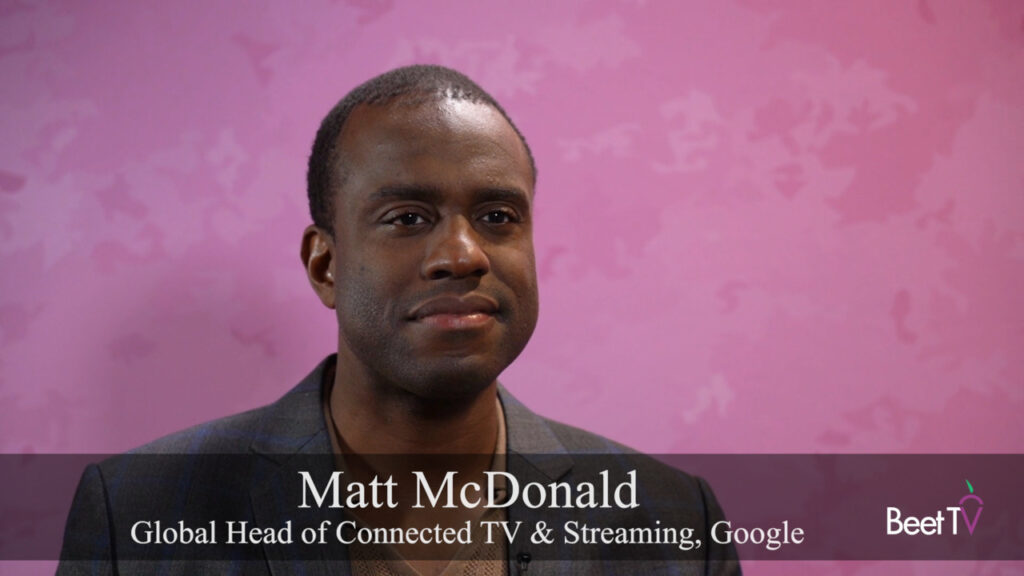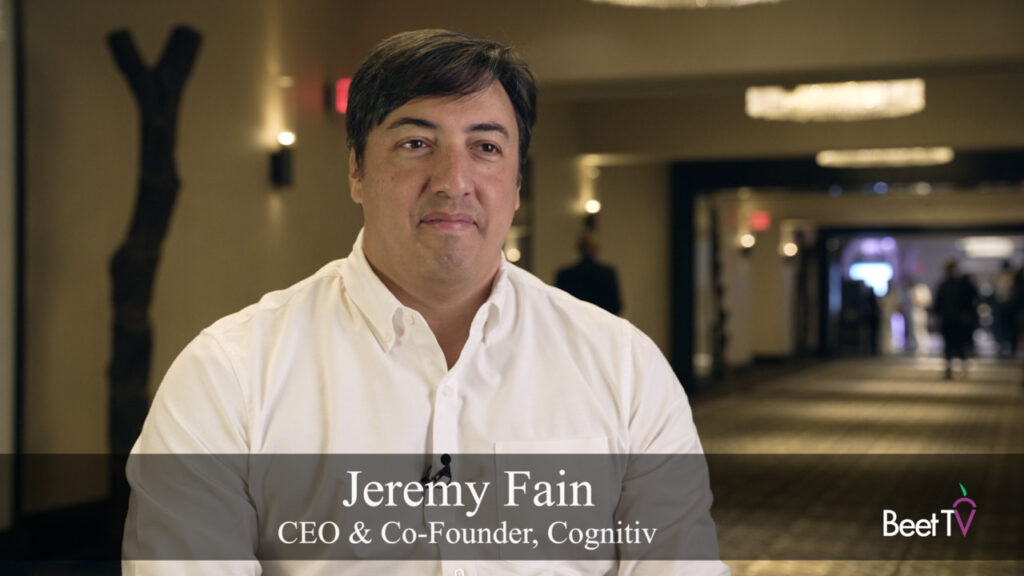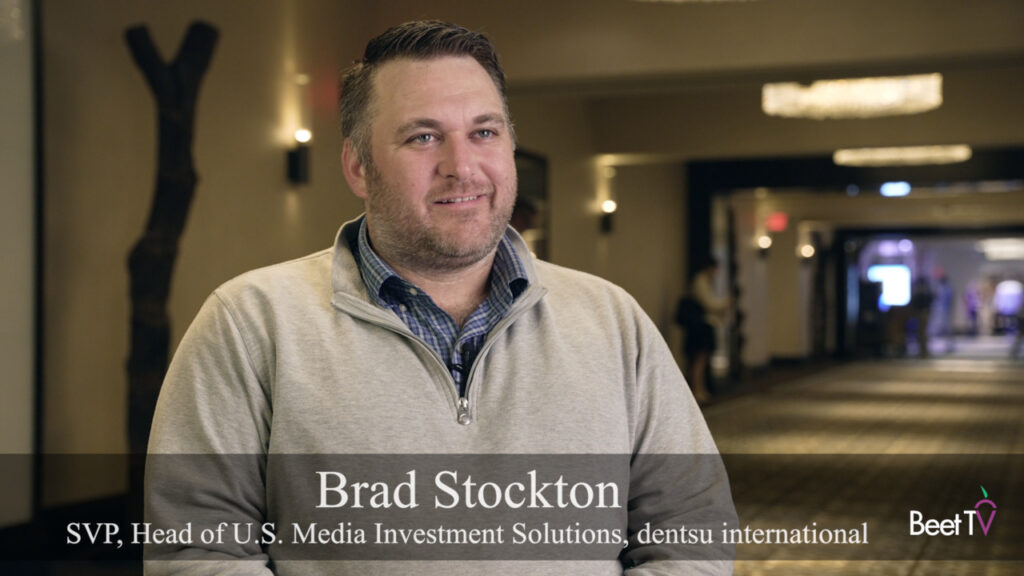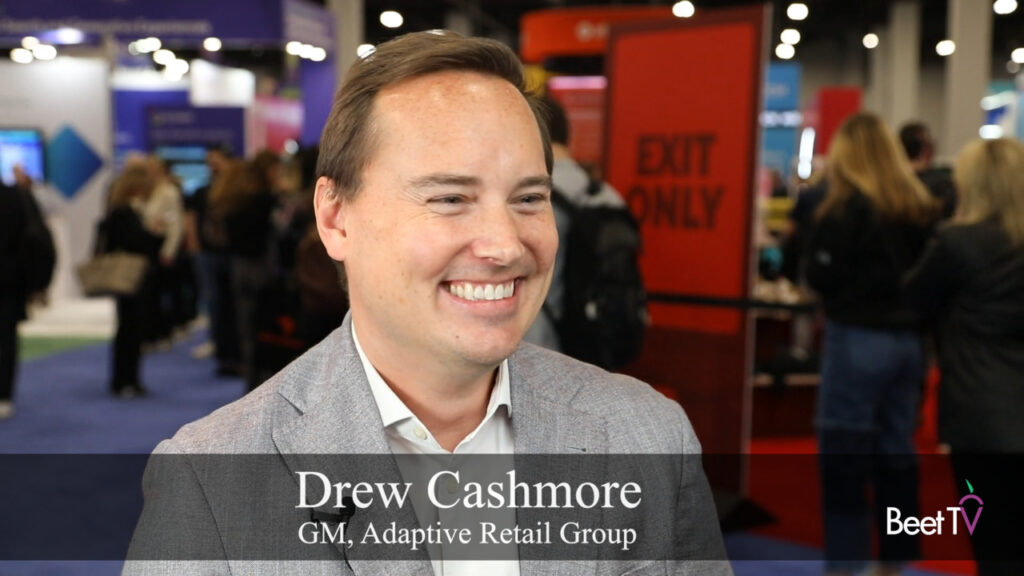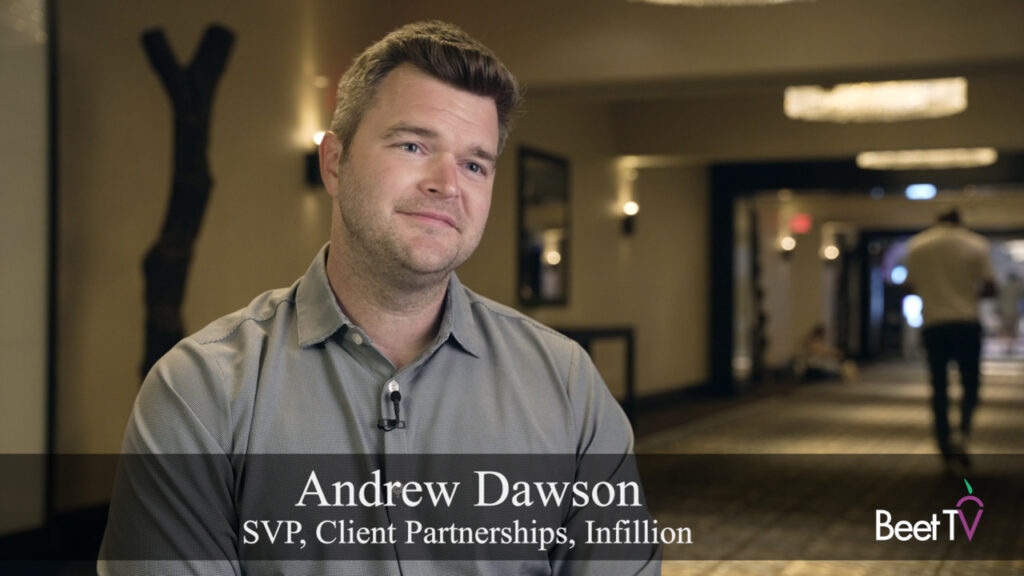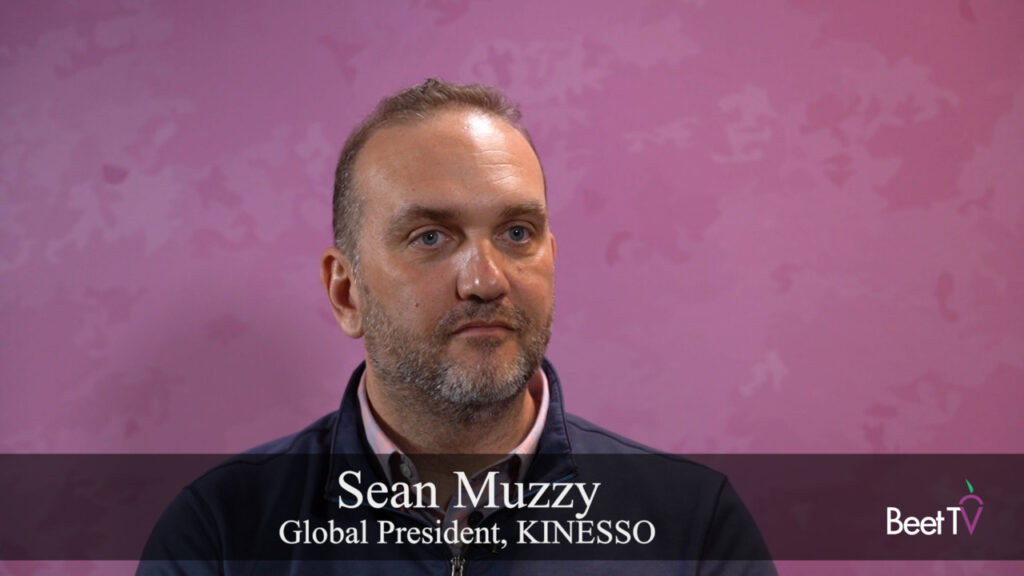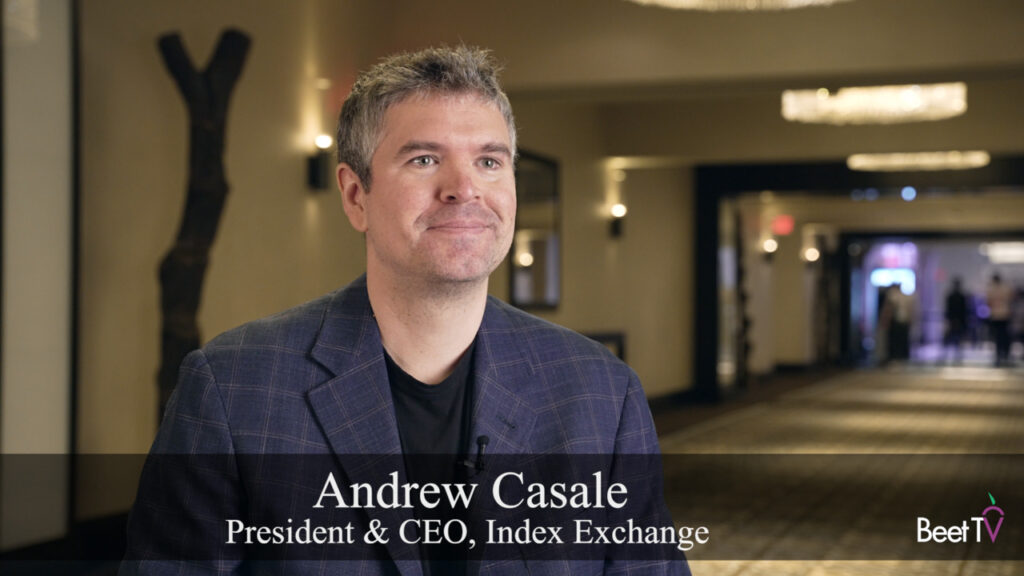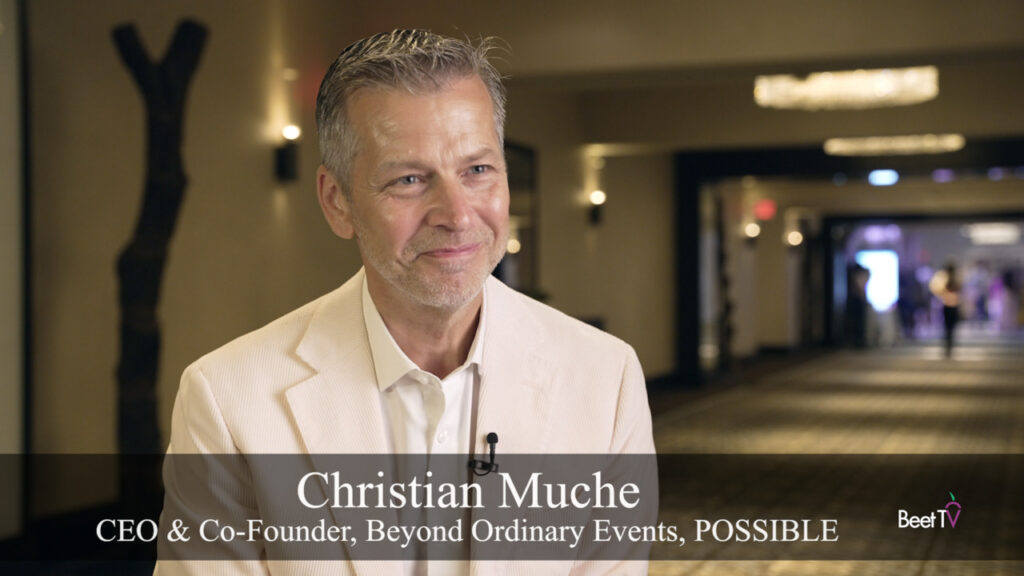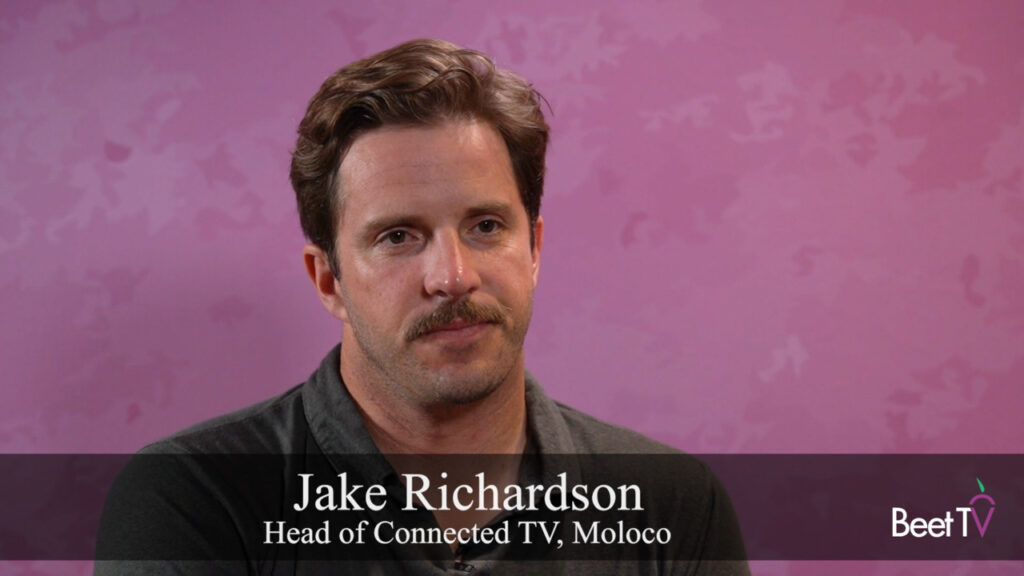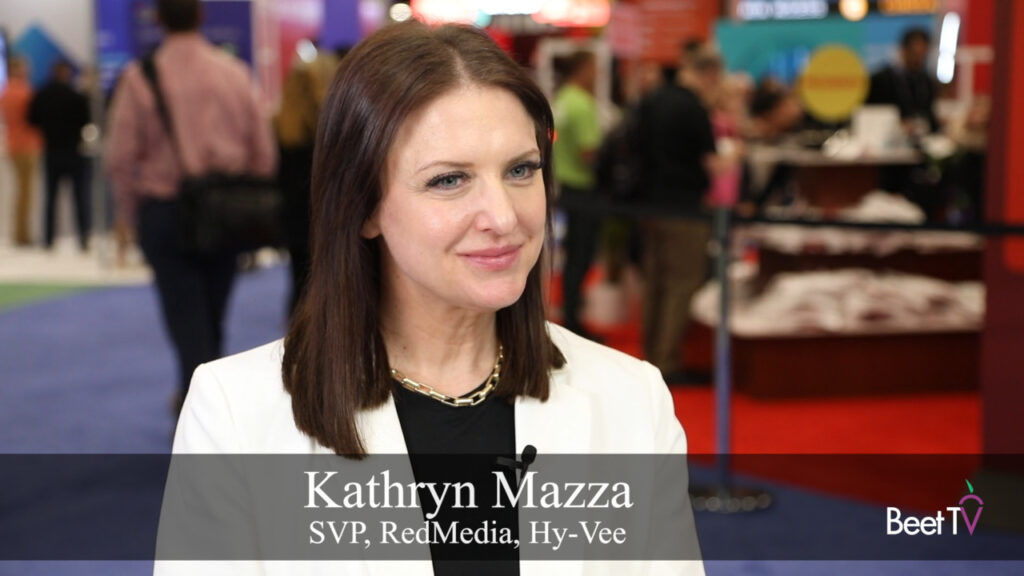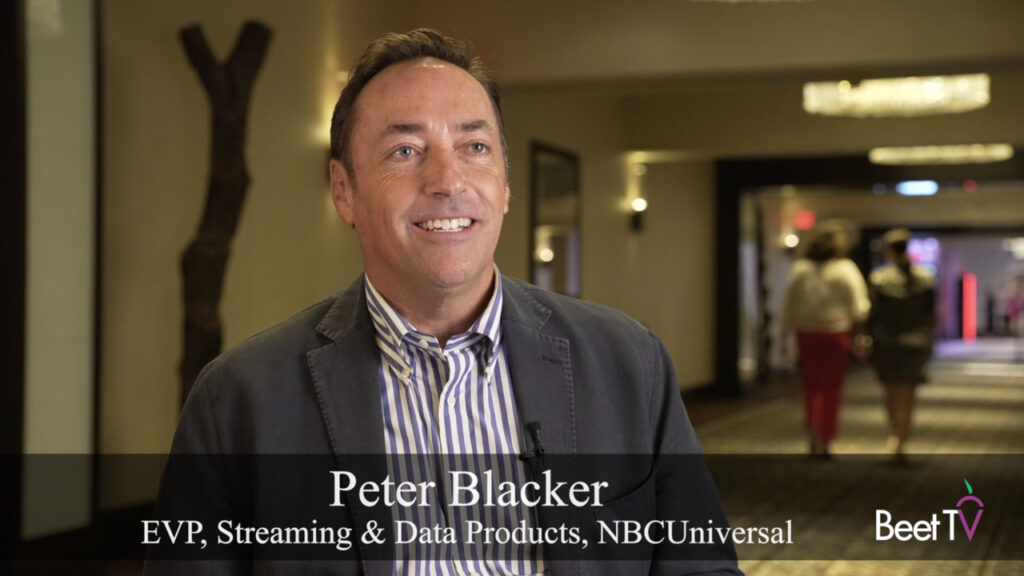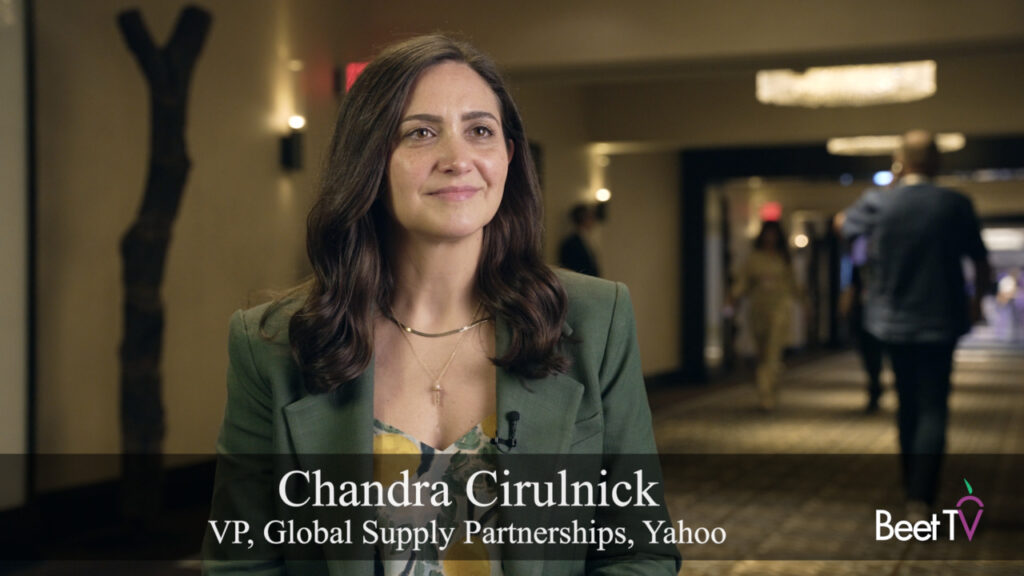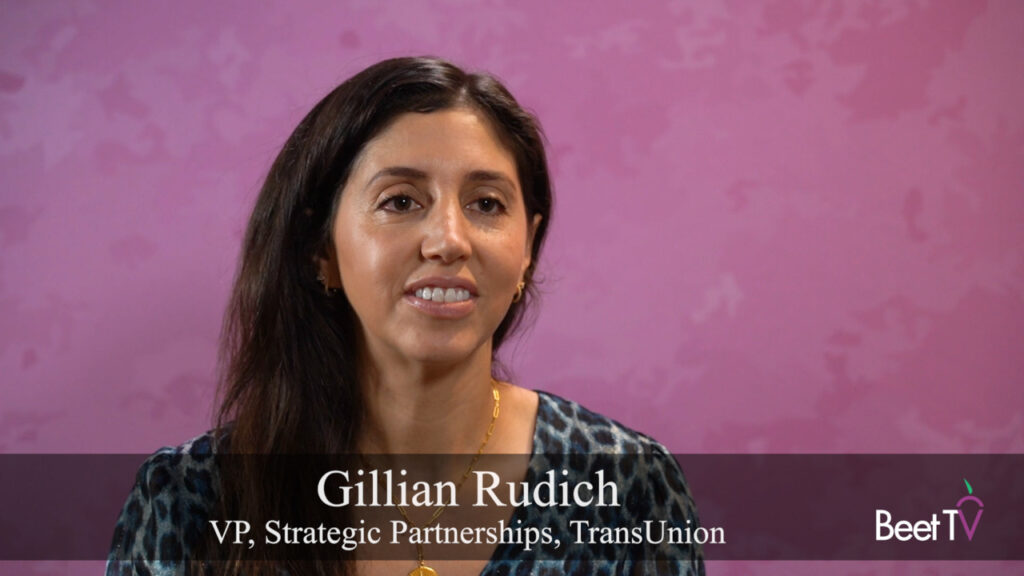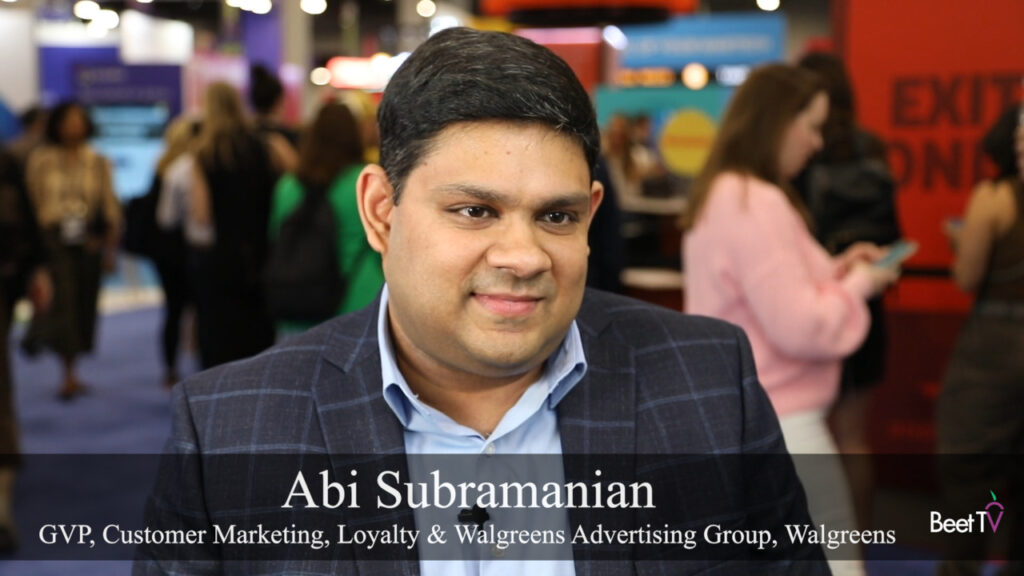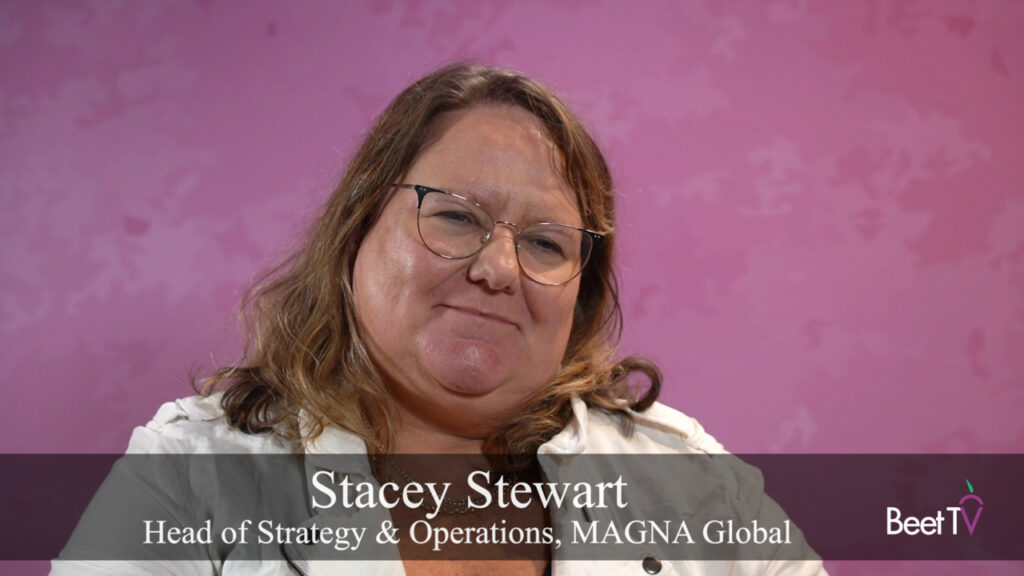
Tania Yuki, who heads video products at comScore, explains how the company tracks video views through links, tags, and via a panel of 2 million Internet users.
She was a panelist at the Beet.TV Online Video Roundtable held in New York last month. She says that the rankings of many video properties will change as comScore will de-link views of content and advertising with its June numbers.
Tania is questioned by moderator Peter Kafka, senior editor of All things Digital Media Memo.
There will be several more clips from the event. To watch the entire event, you can find on demand here.
Full Event Transcription Below
Our live event was streamed on June 22 by Livestream with real-time subtitles created by PLYmedia, employing a real person to transcribe. PLYmedia has provided a full transcript of the captioning, which is posted below. The event was hosted by MSNBC.com and sponsored by YuMe.
I think mostly for the cameras, so we'll hit each one of you at a
time. But this is supposed to be
discussion. So I want to encourage
you guys to jump in, if you agree.
If you disagree, even better, pipe in. It will make for much more interesting discussion than
instead of us going one, one, one.
With that said, I'll start with Mark at MSNBC.com.
A couple of years ago the conventional wisdom on the Web was no one
watched long form video.
Now we've got Hulu sort of exploded that myth.
We're all comfortable with the idea of watching long form video. What does that mean for a site like
yours? How do you guys deal with
that?
Mark Marvel, MSNBC.com: Well, it's kind of interesting. First of all, I run online video sales
at MSNBC.com, which is why I'm here, and also a host, I suppose.
It's really interesting in the sense that when you look at MSNBC, in
particular, and you think about sort of the genesis of online video, the
initial idea was video snacking.
Everyone watched the 15‑ or 30‑second clip.
And we all know there was a great explosion that YouTube created on the
Web that really popularized.
I always say there were sort of two critical moments, if you want to
oversimplify this. And one was
YouTube, which created mass in terms of consumption. But really the next, which to me was the marketing, was sort
of the critical mass in terms of marketing, was Hulu.
I think what Hulu did was create that sort of, the idea that people were
watching TV online.
And so you had what was, from an advertising perspective, what I think
most of us have seen, we were sort of all waiting this mythical, when the TV
dollars shift, right, we all heard that.
And it's a trickle, but it's starting to pick up and I think one of the
critical factors in that has been this movement to longer form content.
MSNBC is really interesting in that video snacking, that whole concept,
really began with news.
And news is still the dominant category of video consumption on the Web.
But what we see is when we create what we call show players for Rachel
Maddow, Countdown with Keith Olbermann, Nightly News Today Show, that the way
people consume video in that show player experience is very different than the
way they snack in sort of a video player that contains all video clips. So we'll see consumption in Rachel
Maddow of 20 minutes or more per session.
Peter Kafka, All Things D: This is because you've embedded in a
specific kind of player?
Mark Marvel, MSNBC.com: No, this is because people are coming
to the site and consuming the entire show.
And, increasingly, what we're seeing is, by show, when we create these
show player experiences, people are averaging upwards of 15 to 20 minutes per
session, per show on those sites.
Peter Kafka, All Things D: Regardless what kind of content it
is.
Mark Marvel MSNBC.com: Yes. It's really interesting.
One other thing I was reading earlier today that was particularly
telling, numerical fact, was the fact that 29 percent of people under the age
of 25 are now watching most or all of their television on the Web.
Peter Kafka, All Things D: So you think they're seeking it out;
they're not doing catch‑up viewing.
One of the lines you hear from people who want people in TV not to freak
out is say this is catch‑up viewing.
Given the choice, I'd rather watch it on TV. But if they miss an episode of Office, they watch it on
Hulu.
Mark Marvel, MSNBC.com: I think there’s an element of
both. And I think one of the
interesting things ‑‑ a group of us were talking about the iPad
earlier. And I'm sure that won't
come up at all tonight… But the
fact is, we're designing an app right now that's really about the interactive
nature of watching a program while you're actually tweeting or doing whatever,
engaged with an audience, and that's not that we're totally unique in that
regard, I think we will do some things that are fairly unique there, but the
fact is I think it's catch‑up viewing.
It's becoming much more engagement with a program as it's actually being
viewed simultaneously.
And then I think what you're starting to see in the content creation
side of things is good content.
I mean, I think finally, you know, I watched this Illeana Douglas
show ‑‑ I think It's “Easy to Assemble,” something like that it's
called. It's filmed at an IKEA
store. And it's hilarious. It's as good as what's being produced
on television.
So we're starting to see episodic content being produced for the Web
that's ten minutes and longer per segment and people are watching it that way.
Peter Kafka, All Things D: Since you brought it up, why don't you
tell us about the iPad app, when can we see it, and what's going to be in it?
Mark Marvel, MSNBC.com: I can't tell you. What I can say is it's one of our
shows. It will be coming out in
the next couple of months.
Peter Kafka, All Things D: Show‑specific.
Mark Marvel, MSNBC.com: Yeah, specific to one of our programs.
Peter Kafka, All Things D: We'll have the full content of that
show?
Mark Marvel, MSNBC.com: Yes, it will have the full content.
It will have interactive features that will allow you to engage with the
host of the show, as well as, you know, other people who are watching the show,
as well as the producer of the show.
It will have a lot of different hooks that actually allow that kind of
social engagement aspect that we're just sort of peeking into right now.
Peter Kafka, All Things D: And when you put that show up for free
on the iPad that your MSOs are paying you for access to, what do you think the
reaction is going to be?
Mark Marvel, MSNBC.com: I think one of the things is you're
testing a new market. So I think
that's a challenge for us every day, right. The fact is, when our stuff is embedded and put on another
site, or what have you, that's always a challenge when you're looking at the
economics.
But the fact is that this is going to be testing a new market that
probably will be very significant.
And that's ‑‑ I wouldn't be surprised if we hear some pushback from
it. But my guess is that it's
going to take a little bit for this market to get going, but it's going to be
big.
Peter Kafka, All Things D: You're in charge of ad sales so talk to
us about what sort of is working and what did you think was going to work and a
year ago maybe got rid of, how has that evolved over the last couple of years.
Mark Marvel, MSNBC.com: Encouragingly, we had, I think last
month was our last month in video, over 150, 160 million. I think 154 million streams.
I think getting back to your initial question, I think what's working
is, from our perspective ‑‑ and there are a lot of different ‑‑ all of
us on this panel represent different interests, including ad networks, which
are the complete antithesis of our business for, in most cases. But the fact is what we see and what
works is brand.
We create a branded environment and people respond to that. They respond to a video player and
platform that lets them know they're watching the Today Show.
They respond to the fact that Brian Williams and Nightly News are
actually extending what they're doing on television deeper for them if they
want to go further, when they're on the Web.
And they provide a different path into information.
So what we're finding is so many different ways ‑‑ we talk about
yield analysis; I've been really involved in trying to squeeze more money out
of the site, but the fact is a lot of the yield analysis is in the value of the
brand and different ways that you can utilize that talent. And so the expansion of that talent on
air to online is huge.
The other thing is testing.
Online is the single greatest testing bed ever created. In part, because you can start producing
content that isn't really ready for television, that you can test and see how
it works and work on that side.
But I think, to your original question, the long form video consumption
is so critical. And I think that
that is such a huge part of the direction we are all heading in, in terms of
what's going to be coming and how we're going to structure our business and
Andy and I had talked before about the dreaded ad pod–the word no one wants to
hear.
But the fact is it's a huge part of what long form content will force us
to confront. Some of us will see
it that way. Some of us will
embrace it and look at creative ways that we can utilize it better, I think,
than it's been done on television.
Peter Kafka, All Things D: If ABC came out, said "We're going
to double our ad load," you'll see two ads instead of one on the iPad app,
and then we're going to move that on to ABC.com, and we're still going to be a
million miles away from the ad load you see on TV.
Do you think you're going to get to a point where online ad load will be
the equivalent of off line?
Mark Marvel, MSNBC.com: I think you'll get to the point where
video, we won't have the same distinction anyway, that TV and online. I think that by the time we reach that,
and Tania has some really interesting research on actually that particular
topic, which is the fact that people are much more willing to view commercials
or longer commercial time than we think.
The threshold is much higher than we think for online.
We've been terrified, we can't get in front of it. Well, that's been a factor of the
nature of short form content. When
you had a 10‑second clip at the beginning of online video and it took you three
minutes to buffer for that clip, and you finally got through the commercial,
and then you got hit by the same commercial, you know, you killed the
viewer.
Peter Kafka, All Things D: You don't think there's a consumer
expectation that I'm watching online, therefore there's less commercials,
they're not skippable, therefore there's less commercials?
Mark Marvel, MSNBC.com: I think that's fair. I think what's happening, though, that
initial thing is changing with the technology. So those thresholds are changing because content is loading
so fast by comparison to where we were.
The amount of video that we're consuming is much longer. The expectations have changed because
the nature of what people are consuming and the infrastructure that's
supporting it is changing. And I
think that what's surprising is how fast that has happened.
I've been in the business for three years.
I remember, you know, we're talking about broadband penetration as if
that was a huge fact. Like, wow,
it's 59 or 60 percent. Well, we
don't even think about it now.
Now it's beyond, broadband is like what's the latest connection speed,
or Google is rigging like a whole town to run at like speeds we've never seen
before. So I think that that has
changed the nature of those thresholds.
Peter Kafka, All Things D: Scot, you work directly with these
guys. Actually providing the
embeddable player they use. Can
you weigh in on this, sort of what formats are working and what aren't?
Introduce yourself first.
Scot McLernon, YuMe: Scot McLernon, Chief Revenue Officer
for YuMe.
And it's interesting, because, Mark, we can play point and counterpoint
a little bit. But I have sat in
your chair. I was the head of
sales at MarketWatch, head of sales at CBS Sportsline, CBS News, where you
could say we had kind of a finite amount of inventory.
So your points about long form, and while very valid, it's interesting
that we’ve actually taken a completely different approach. And that is that the average
consumption of video is about four minutes online.
So you've got a massive amount of consumption in those two‑minute, three‑minute,
you referenced, the 15‑ and 30‑second clips, which is where we kind of
began. And now it's gravitated
towards, yeah, there's more long form.
And I guess my other counterpoint would be I'm not sure that that is necessarily
the only direction in which we're going, which is a reference you made.
But I think it's in addition to what we have. I think we'll always have that two‑minute consumption, that
three‑minute consumption, that four‑minute consumption. And I think it's terrific.
I've got a user study of one in my house. My 16‑year‑old son, who probably isn't going to see a 30‑second
ad other than online in his life, because everything is time shifted. He uses the DVR, or he watches
online. And that's where he learns
about the various QSRs and others that are advertising out there to him.
So we do see that short form is right in our wheelhouse. We specialize in that. And the other part is I think it's
because MSNBC specializes in finite, much like MarketWatch did, where YuMe
specializes in scale.
So if an advertiser wants to really reach a massive amount of audience
in the 18 to 34 category or the 24 to 35, 25 to 54‑year‑old female, they can
come to us. If they want to really
have a massive amount of bang in that, inside of a long form, then I think
that's a terrific format for you guys.
Mark Marvel, MSNBC.com: Just to answer a couple of those
points, because I think the scale thing ‑‑ and we see that, too. I think you're right, there's a
complementary nature where you have to realize your strengths and weaknesses.
One of the things that the networks do effectively is scale and
targeting. And I think we go to
you guys for part of that. We work
with you.
Peter Kafka, All Things D: Want to tease that relationship
specifically?
Mark Marvel, MSNBC.com: We have a remnant with our remnant
video.
Scot McLernon, YuMe: I prefer to call that unsold.
Mark Marvel, MSNBC.com: Sorry.
Peter Kafka, All Things D: The inventory you can't sell, Scot
sells.
Scot McLernon, YuMe: Yes, that's correct.
Mark Marvel, MSNBC.com: But a couple of points, and I think
that what's interesting there is when you're talking about the nature of the
shorter form, we have both.
The fact is we have, what I was saying before, we create show players
for shows where we see 15, 20 minutes of video consumption. We have a pop‑up player that runs all
video in the site. That averages
five minutes per viewer, exactly what you're talking about.
So it's very interesting from our perspective, because we monetize, we
have a unified policy of monetization.
But when I'm talking about really trying to get to yield analysis, we're
looking very closely at how do we monetize short form more effectively; how do
we monetize long form. Because I
think they are somewhat different animals.
And we're not even talking about engagement models and keyword
extraction and some of the stuff you could do that really ‑‑ you can't do
with television because there's a different level of information you can pull and
engage a viewer with clickable video and some of those kinds of things that
really change the nature of advertising altogether.
So an ad pod isn't a 15 or 30, it's a lot of different kinds of
things. You could do the show
without a pod, you could just be engaging with the ad as you're watching.
Peter Kafka, All Things D: I have a general question for the
audience. Do we believe more
considerably we're going to get to a point where viewers aren't going to
distinguish between online and regular TV; they're going to do it as one in the
same? But, Scot, you seem to think
there's a certain kind of behavior that you're going to associate with online,
stacking and stuff.
Just in general, do we think there's going to be a distinction between
viewer behavior, I'll do a certain thing online, do a certain thing on TV?
The premise of Google TV, right, is we're all going to do this on one
side, it's all the same thing.
Agreed? Disagreed?
Bob Mason, Brightcove: I think it has less to do with the
platform than sort of the persona of the user when they want to engage with
that content. So if you're sitting
down for lunch, you're really looking for snackable content that you can sort
of engage in really briefly while you're eating your sandwich. But if it's in the early evening and
you've pulled out your iPad, and you're sitting on the couch, you might be
looking for watching a lot of long form content.
So I actually think we are going to have these two sort of polar
worlds. We'll have a lot of
content that, sort of ‑‑ the mass amount of content will sort of be probably
done on the short form clip side, but increasingly, over time, we're going to
have more and more of this long form content.
We definitely need to have different ad policies, different technologies
and different sales strategies for each of those different user experiences.
Scot McLernon, YuMe: I think marketers are going to be very
interested in the studies that come forward; we're building one right now that ‑‑
I'm making a bet. And that is that
we're forming an audience right now that does not actually consume any
television through the traditional means of television; that all of their sites
in motion, whether it be 30 seconds or it be two hours or an hour, to
Mark's point a moment ago, that all of that is done in some kind of iPad or
iPod or laptop form.
And that for the marketer to reach that audience, they're going to have
to utilize online and actually probably defer to the three marketers in the
room for that for feedback to that.
Andy Chapman, MindShare: Andy Chapman with MindShare.
I think the way I start to think about this, and as we do some of the
evaluation back at the agencies, is there's a sense, in my mind, that there
will always be some kinds of programming that will engender themselves for
certain types of devices.
Some of them are going to probably tend to be more geared towards the
lean back mode, the couch, the big screen, and that might be some of your more
appointment viewing types of events, whether it's the Oscars, the Grammys,
whatever, live sports, things like that.
It's interesting to hear Mark to talk about news. And that he's seeing more of a lean
towards some longer form types of programming in news. Whereas, my gut tells me ‑‑ and I
think we need to do more research around that ‑‑ that news probably in
general lends itself very much towards that snackable approach and could be
used on many different devices. It
has a short shelf life.
It's probably not the type of thing that you're going to time shift the
way you do on a DVR or watch a full episode player on Hulu, which in my mind,
in many cases, is really sort of a no‑cost DVR for many people. It's a way for them to catch up their
show without having to pay the cable company for a DVR or Tivo. So they've been trained to do that
because it's free.
So I think as those new subscription models come online, as those get
tested, I think that might change a little of the dynamic about the way people
view and access some of that content relative to news programming or other
kinds of programming.
So I think a lot more work to be done around the way people use and
interact with certain types of content.
Scot McLernon, YuMe: I remember about ten years or eight
years ago Yahoo! did a study called Born To Be Wired. Remember when they did that? I would be fascinated to see somebody do that again, because
the generational shift, like I said, I'm watching it in my own house, is really
amazing. Other than live sports,
everything seems to be consumed on that boy's laptop.
Andy Chapman, MindShare: Probably put that in a shredder right
now and redo it. Because it's very
different.
Adam Shlacter, MEC Global: Adam Shlacter from MEC. I work with Andy.
I agree with everything he said.
But I would say that as consumers become more device agnostic to consume
content, content will just be readily available. It will be just an expectation that whatever device I pick
up or I turn on, I should be able to have some sort of dynamic experience.
So if it's rendered for an iPhone versus a 65‑inch screen, which is what
I think is behind you guys, it will be the appropriate experience for each
device sort of regardless of where I am, what I'm doing at the time. That's what the expectation will be.
It hasn't been because, to Mark's point, all the things we've dealt with
up to now, has been slower connections, things that buffer, stuff that's been
produced in a variety of ways.
You're watching a lovely HD program on your iPad and then there's a non‑HD
commercial put into it. And it's
kind of a turn‑off for a consumer, especially if you're forced to have that as
part of your experience. Until
things become more sort of seamless across screens, like true multi‑screen
consumption, it won't happen. It's
either not readily available right now or just not that good.
But with more and better connected TV sets and wireless devices continue
to come out at a really rapid clip.
Like if you went to see "Yes" this year, you basically got a
preview of what's out now versus what might be out in two or three years.
So as that keeps happening and people keep adapting and catching up to
what the latest and greatest is, content producers and distributors are
naturally going to figure out how to get their stuff across every screen no
matter where it is because that's what people want.
But from an agency, planning or marketer standpoint, the challenge right
now is how do I capture all of that and how do I understand who I'm reaching,
when I'm reaching them, where I'm reaching them. It might be the same person across any number of these
screens, across a day or a week or a month or whatever the time period is. There's really no measure for that
right now, at least no single source.
And I think that's what's probably the more complex challenge from an
advertiser standpoint
Peter Kafka, All Things D: We're going to talk about measurement,
I think, some more when Andy starts interrogating you guys. Let me back it up even further.
Ping Li, you're an investor in, I think, almost everyone who is sitting
here, you've put money into.
But specifically comScore, Brightcove and YuMe ‑‑ and a fourth.
Andy Plesser, Beet.TV: The series with Beet Media, by the
way.
Peter Kafka, All Things D: So you've been betting on the sector
for a while. Has your thesis
changed at all over the years as the sectors evolve, or do you believe the same
thing now as you believed a couple of years ago, and it's just sort of paying
out?
Ping Li, Accel Partners: I think some things have changed and
some things are similar.
I think one of the big shifts, I think, a lot of us are talking about
now, video until recently has been a single screen phenomenon–tt's been around
the TV. And as it shifted from
multi‑platform, it's created a whole new set of opportunities for technology
companies to actually solve the problems that it creates, right. And I think the first problem is around
the PC.
And we got excited around things like Brightcove and YuMe and comScore,
frankly, to figure out how you can add value to that ecosystem as they got on to
new platforms.
I think what we're seeing is that platform proliferation is
accelerating, not decelerating. So
the thesis that anytime new media goes to new platforms it creates new
opportunities, I think it's completely true and still valid.
The last couple of years around the PC going forward, you really have to
look at the mobile platform. And I
think the mobile platform is much more than the phone now. But it's the iPad, it's the portable
devices. I think that creates
another set of technology challenges, a set of innovation that's going to
happen, whether it's on the measurement side, on the delivery side, the
monetization side.
I think the challenge, I think, we're all alluding to is anytime there's
a new platform, the first thing you do is port existing stuff to it. When TV first created, it was a guy
like just talking to the TV screen as if he was a radio announcer. And I think that happens in any new
platform evolution.
So what first happened on the PC was people said, hey, let's just put TV
content we have on the big screen on to the PC. And that had some success, but not everything ported over.
Then YouTube came along and showed there's new formats and new
technologies like flash, et cetera, that people can get excited about a new way
to consume media.
I think that evolution is just at the early stages, that there's still a
lot more to do. I think the iPad
is going to create a whole new set of applications we haven't even seen before.
Peter Kafka, All Things D: So we should think about creating
different kinds of content, different packages of content for the iPad, simply
because it's the iPad, different sized screen, I'm using it differently.
Ping Li, Accel Partners: I think I'd go further than that. It's not just the different size screen. I agree, let's make it smaller, higher
fidelity for a smaller screen. But
how do you integrate location‑based functionality of the iPad into a viewing
experience?
The iPhone has a gyrometer.
How can you integrate an ad experience wit that capability?
So taking advantage of the endemic platform for building new content and
new ads is, I think, where a lot of the innovation is going to be coming
from.
Peter Kafka, All Things D: On the flip side, I remember a few
years ago, first wave of mobile came out, mobile video, people were creating
studios and separate editing suites just to create sort of mobile‑specific
video, the idea was you would want to shoot a sports show or talk show or
something specifically for mobile phones.
That seems to have gone away.
Is that because they were wrong and there's no need for that or the
economics didn't work out at the time?
Ping Li, Accel Partners: I think it's a little bit ‑‑
there's two things. One, I think a
lot of people looked at the mobile platform as a smaller TV screen, shooting
things for that as opposed to saying what is the use case, I think as Mark said
earlier, or Bob, when they're using the mobile phone, what is the stuff they
actually want to watch and how do they want to consume that type of content.
I think people are understanding the use cases around mobile a lot
better now than they ever have.
Because before the mobile was just a phone. Using it to make phone calls. People weren't thinking about it as a media device. I think that's fundamentally shifted.
I think the content in the past may not be the type of content we'll see
going forward. And I think the
other point you touched upon is the other shoot and drop is how do you monetize
mobile. We were investors in a
company called Ad Mob, now a part of Google.
And I think their ability to monetize kind of more text‑based and banner‑based
type content really created an ecosystem that sucked developers, application
people to the mobile platform, and Apple and Google are continuing to opening
up those platforms for other developers.
So I think that's going to happen with mobile video as well.
Peter Kafka, All Things D: Any video stuff you don't want to touch
at all after the YouTube/Google deal, big rush of sort of next generation, YouTubes
and a lot have hit the wall and gone away?
Do you see stuff like that on the horizon now saying I want to stay out
of that sector, it's overbought?
Ping Li, Accel Partners: I think there's still ‑‑ there's
still a little question around a lot of the over‑the‑top stuff, which is direct
to a media device. And I'm not
saying that the Google TV stuff and the Apple TV stuff won't work, I just think
it brings a set of complexity when you're dealing with some of the studios and
content and licensing of that content.
And it's a question mark whether a start‑up can actually effect that
ecosystem.
Peter Kafka, All Things D: You'd rather not be boxed, trying to
navigate between Hulu ‑‑
Ping Li, Accel Partners: Boxee seems to be getting some
traction, but others that have not seen the light of day, have tried to see the
light of day but quickly died.
That's an area you need to be careful of from an investment
perspective. We haven't seen that
ecosystem open up as much as the mobile phone, for example, or the PC.
Peter Kafka, All Things D: Allen, I think you're the only content
creator here. I wanted you to jump
in at some point.
Allen DeBevoise,
Machinima.com:
My name is Allen DeBevoise, CEO of Machinima.com.
And one of the key differences, I think, with the new brands or brands
that are born in kind of this era is that the key difference is really
engagement. And I don't mean just
kind of intellectual engagement, like you might watch the Sopranos, but actually
physical engagement, what you do with your video in Facebook. You comment on your video. You rank and rate your videos. You actually create videos as responses.
So I think there's always this assumption we're taking the static thing
called linear content and we're dropping it on another platform and that's all
that's going to happen. But, in
fact, that's not the behavior that we see. Online certainly, I think, mobile and these iPad type
applications.
So I think that level of physical engagement is an important part of the
endemic quality of the new way that people are dealing with video. It's part of a social experience.
It's part of a interactive or an engagement, physical engagement model
that doesn't exist in traditional models.
I don't think the answer is just let's take the Sopranos and throw it
online, somehow that will work. I
think we'll see all sorts of behaviors.
But what we see, certainly, on YouTube and on Facebook is a lot of
activity around what people do with those videos as well.
Peter Kafka, All Things D: The stuff you create is sort of
response, to begin with, right? It
started off with you guys taking Halo animations?
Allen DeBevoise,
Machinima.com:
Right. It's response for
that perspective. And we see
enormous activity from the audience itself in terms of commenting and ranking
and doing video responses to a video that you've already created and that's
kind of a new generational thing.
And that's obviously easier to do with tactical devices ‑‑ if you
can sit across a television screen is a little bit more complicated to do.
Peter Kafka, All Things D: You spend a lot of time on YouTube and
looking at those comments. And I
think a lot of people here, if they see comments on YouTube, kind of freak out
because they're often very often sub-neanderthal, and folks, there's no value
there.
In fact, is there a way I can hide these comments because they sort of
diminish the value there. But you
see there's something there to mine or respond to or extract value.
Allen DeBevoise,
Machinima.com:
Absolutely. It's the audience
engaging with what you're doing.
And you can start to think about other kinds of things and other kinds
of program. It's really a feedback
loop.
I think we need to think about it.
It's not some content creator creates content and throws it up there and
we watch it passively.
This iterative and feedback loop will be part of the ecosystem from
something that's fantastic like say "The Pacific" on HBO that's large
and high scale, all the way down to kind of snackable content that people are
engaging with, commenting on, dropping into their MySpace pages or Facebook
networks, or whatever that case might be.
Peter Kafka, All Things D: Is YouTube your primary outlet, is that
where the majority of your page views come from?
Allen DeBevoise, Machinima.com: We did like 128 million video views a
month last month, we did that. And
what's great about YouTube as a platform is obviously you're global and you're
on every device very quickly.
So I think one of the things that brands like us that think of ourselves
in the same way that cable networks grew out of a new platform, we think of
ourselves as a new brand that comes out of these kind of platforms, is that
really being across all these platforms and expressing the brand in these
different environments is really key.
And being good at short form content and long form content at the same
time is actually, I think, the essence of where it's going to be.
Peter Kafka, All Things D: A lot of content companies go on
YouTube when they want to direct people back to their site. That's what ESPN is trying to do.
Are you comfortable with people only engaging you on YouTube, or do you
want to bring them back to your site before you can really say?
Allen DeBevoise,
Machinima.com:
No. We have significant
presence on YouTube. We're not
only comfortable with that. We
keep trying to grow that.
And obviously we think there are four major platforms out there. The IOS world, the Android world,
YouTube, Facebook, as an example.
And they're all crawling into all of these environments. We'll be on every single device,
including TV sets.
And I think you as a brand have to think of yourself in those
environments and make sense.
So I think it's less important to think of yourself as a TV network
rather than a video programming brand, because, quite frankly, I don't think
the television industry will innovate anywhere near as quickly as Apple and
Google and Facebook.
Peter Kafka, All Things D: I think people who do what I do tend to
ignore Facebook from a video perspective way too much, for whatever reason,
because we're bad at what we do.
But can you talk about what Facebook means to you as a video platform,
how it differs from YouTube?
Allen DeBevoise,
Machinima.com:
What's interesting about Facebook is ‑‑ obviously you've seen the
numbers. They've actually started
to grow their video platform pretty significantly, and we're just starting to
do some things on Facebook.
But what's interesting about it is that you can built applications that
can be built around video.
We built, for example, for this game Modern Warfare II, we built a
tournament like an NCAA‑type bracket tournament, which took place on Facebook
but used video as the center of what it was doing.
And it's interesting as an environment, because it's not just, again,
it's not just here's a video player, watch this, but, rather, you build an
application. Video may be part of
that application. And you engage a
network of users and try to grow that network. And that's a different way of thinking about video as an
experience. And it was actually
sponsored by television network.
And so it was kind of an interesting model.
Peter Kafka, All Things D: Bob, Brightcove, initially sort of one
of your jobs was to create ways to let publishers publish on different video
platforms. It seemed like that
condensed into sort of, all right, we figured out a couple different
platforms. Now it's exploding
again.
I assume that's more opportunity for you, the fact there's an HTML 5
issue, the fact you can go to Facebook now as well as YouTube. This is good news for you, right?
Bob Mason, Brightcove: It's good for us that there's more
problems to solve. Our goal here
is to reduce cost and complexity for our customers. And that complexity curve keeps going up higher and higher,
year after year, so it's certainly good for our business.
I think for the industry as a whole, you know, it will be good as more
and more standards evolve and sometimes don't necessarily have to be technical
standards.
They can be best practices on patterns that really drive business and
innovation. But major media
companies and brand marketers use a platform like Brightcove because they want
to control their own destiny around distribution of their content across all of
these major devices.
So that's why we have significant product investment in HTML 5
solutions, the IOS platform, Android, Facebook, because our customers actually
do need to be able to manage their video distribution and have an effective
monetization strategy across all of those key touch points.
And they really see this hybrid strategy of having their own Web
destinations, syndicating content out of partner websites, using social
networks, using YouTube, all as part of a coherent strategy.
Peter Kafka, All Things D: I hear split things from publishers.
Some say I really need to be on HTML 5 because that's where it's going
and people will want to experience my stuff on the iPad. They say I'll get there one day, but
right now there's not enough audience to make it worth my while. What are you hearing?
Bob Mason, Brightcove: The way we look at the problem is we
don't want our publishers to even have to worry about that from a technology
choice.
So our goal is to actually to allow them to focus on what they do best,
which is actually creating the great content, marketing and monetizing
that. So our publishers, when they
choose to use a platform like Brightcove, they don't necessarily have to worry
about a lot of those technology choices, we can just try to help simplify and
get the content on as many platforms as possible.
Peter Kafka, All Things D: But you're charging them for that.
Bob Mason, Brightcove: For example, the HTML 5 solution, you
don't pay extra for that. So you
sort of get that for free as part of your solution.
Our goal is to get distribution for our customers,
and as many technology platforms and technology solutions and partners that we
can work with to allow them to drive their business is good for everyone.
Mark Marvel, MSNBC.com: It's kind of interesting, because from
what Allen was just saying, and, Bob, your focus is commodifying or
commoditizing content. I think to
Allen's point immediately before that, really talking about the fact that it's
about creating the content in a unique way that doesn't kind of commoditize
it. It's about the experience.
So that I think we do end up ‑‑ and I think this is a really
critical point in online video right now, are these two forces. One is sort of the commodifying force
and the other is…
Bob Mason, Brightcove: I would say commoditization is probably
the wrong word. We try and
increase the ROI on the content that's actually being produced. So publishers that are using our
platform really think about, from the very beginning, how they're producing the
content.
I think just an example of this show, you have a Livestream going
on. You can reuse that content,
clip it up.
But we want to make sure from a technology platform solution that if
they want to go to all these different device platforms, they can do that at
the lowest cost possible.
Mark Marvel, MSNBC.com: If you're the publisher, for example,
taking HTML 5, and you're not familiar with the ins and outs and strengths and
weaknesses of HTML 5, you're not necessarily going to produce content in a way
that's going to be unique to that platform in the first place.
So I think that ‑‑ I'm not necessarily even saying that
commoditizing is a bad thing. It's
just that I think we are at a threshold right now and it's going to grow.
And, you know, to Scot's point earlier about scale, this is scale and
this is what it's going to look like.
And for a lot of us, well, for all of us, in some way, there's going to
be a tension between how quickly we can scale and those kind of forces of
trying to make things unique for the experience itself.
Ping was saying before about the gyroscope or whatever on the iPad. Well, when we talk about the economics
of the iPad alone, right, what is i‑ads is basically, I know this is basically
a subject that we were probably going to talk about tonight, but that in
itself, the fact that Apple is going to, for the most part, own those
experiences, be the ones that can build that into the advertising platform
uniquely for that hardware, well, that's a very powerful thing.
And that's a very important ‑‑
Peter Kafka, All Things D: Powerful or limiting?
Andy Plesser, Beet.TV: Or scary?
I was at the All Things D conference a couple of weeks ago. I was there for Steve Jobs' opening
night and Walt Mossburg had a nice discussion with him. It was a great session.
And one thing that Walt said is there's all these like amazing flash
pages, sites, rich, that I love, and they're not going to be on the iPad
because you're not going to have Flash.
And Steve said, well, you know, we're creating the best thing we can for
the consumer. And he gives
his ‑‑ that's his line. And
he says that a lot of stuff is going to be in HTML 5. And he said, by the way, when you look at it – and Walt
said there's a lot of empty spots on the iPad because of flash and Jobs said
the only place that's really empty are the ads.
And it was like ‑‑ it was almost like the ads were a second part of
it, which I thought for advertising and media it's kind of scary, because then
he also went on to say that there's this big transition to apps, to the app
world. I mean, this is their thing
and then they have the i‑ad, and Peter has been reporting about and you
referenced.
I think the question is maybe for the marketers here, for our agency
friends, are you guys scared about Apple and what's up with this new move to
apps? And, in fact, the apps that
are coming out are not really integrated into the advertising ecosystem really
yet or they may be. But what are
the challenges?
John McCarus, Digitas: Before we get to the ads discussion, I
also want to pick up on what Allen was saying.
John McCarus from Digitas.
We have a digital platform called The Third Act.
Andy Plesser, Beet.TV: Speak up a little bit.
John McCarus, Digitas: I think the issue of convergence really
comes down to what are consumers using these different devices for more than
anything else, rather than focusing on whether it's device agnostic.
It is device agnostic. But
it's really ‑‑ I think the line is drawn more around lean back/lean
forward. And if we're consuming
television on the Web, yes, we're going to do that; yes, we're going to scale
that, yes, we're going to talk about how to figure out how to be more efficient
about distributing and buying it.
But there's this whole other piece, which is the lean forward
opportunity, that certainly from the standpoint of brands and our clients is a
huge place to play. And if you
want to think about the Web, if anyone believes it's a two‑way medium, we have
to start to think about how we're going to leverage that opportunity for brands
and figure out how we're going to drive engagement in all its various forms
across the right screens and the right platforms.
And if you want to think about apps as one of those ways to get there,
you know, it absolutely is in the mix.
Peter Kafka, All Things D: Those are also the one‑off right now,
right? An app buys one‑off
experiment, you guys are happy.
John McCarus, Digitas: I think it's fair to say, yes.
And, yet, if you start to think about in the digital media mix as a
brand, with a presence, what we're seeing is that brands are wanting to play in
all of these places at the same time.
Scot McLernon, YuMe: Let me ask a question. As the revenue guy over here, I get a
little bit lost in terms of apps that don't have ads, right, to Andy's
point. Mark was talking a lot
about content that didn't seem to have a lot of advertising support around
it. So how do apps get supported
if not through advertising.
How does it all get paid for?
Adam Shlachter, MEC Global: Subscription.
Scot McLernon: One more question, I don't mean to
hijack the questions on the panel, but I can think of one successful
subscription model on the Web.
>> It's probably not safe for work.
Scot McLernon, MEC Global: Sorry, two.
Andy Plesser, Beet.TV: Hold on a second, guys. One second.
You guys have created an app for the Financial Times, Brightcove
has. How does that work?
Is it part of their paid offering?
Are there ads in it? What
are the opportunities for some publishers now to make a business out of apps?
Bob Mason, Brightcove: I think when we first sort of look at
the mobile opportunity, we sort of divide it into two different sides: we have
what we call the mobile Web and mobile apps. And they're sort of driving on different uses and
different user engagement.
Mobile apps are there for your most loyal fans, the audience that wants
to have a strong persistent relationship with you. And in many ways they're going to be the most valuable
audience, because they're going to be the repeat users with lots of
engagement. And it's going to have
a lot of brand loyalty.
So I think where Brightcove plays in that mix is enabling a technology
to allow the Financial Times sort of build a platform that extends their brand
and their content out to these app platforms that allow for their most loyal
audience to really engage with their content on a consistent basis.
Peter Kafka, All Things D: So if your mobile users are the most
loyal and most valuable, does that mean they should get it free, or would they
be more willing to pay?
Bob Mason, Brightcove: I think we're all trying to figure out
those questions right now, to be honest.
If there was a clear answer to that everyone would be sort of
replicating that model.
Peter Kafka, All Things D: Seems like conventional wisdom right
now is people will pay for mobile either because we say they will or because
they perceive value there. Did you
folks think that mobile would be a paid video experience?
Mark Marvel, MSNBC.com:
I was going to say it's macroeconomics.
The subscription base is very different than the pay wall of 20 or 30 or
$40. It's $1 for an app or $2 for
an app. What you're dealing with
is a different kind of economics, if you call that subscription or fee‑based,
versus the free Web part of it, which is really driving scale and advertising.
So in the app world right now, what's interesting is to some extent it's
a little bit of what we saw in the early days of video, which is can you create
an original program for me, here's the budget. We really don't know what we want; we want our own thing, so
here, go do it.
And I think there's a lot of that being done with apps today where
people are saying create an app, it's our app.
And the other part we're trying to figure out, what is that
threshold. Does it scale
effectively to charge $3 or $2 or $1, or are you going to get more efficiency
out of getting more viewers into that app so that you can charge against the
advertising?
And some of them, ultimately we may come up with hybrid models that do a
little bit of both.
Tania Yuki, comScore: If I might jump in. I guess to maybe take a bit of a step
back and just review where we're at with respect to video advertising, period. Sort of just putting mobile to one side
for a second.
I think we've come a long way as an industry to find innovative ad
formats and to monetize and to look at different ways to deliver brand value.
But the truth of where we're at right now is that roughly 1 percent of
viewing time is ads right now, compared to 99 percent content on the Web across
the board for online video, generally.
That's increased when you look particularly at long form TV programming
which is typically somewhere close to 6 to 8 percent, but it's still really
low. So we're still really kind of
working this out. So I think
that's one thing.
I think to pick up on your point, Mark, of where is that sweet spot
between willingness to pay versus willingness to take ads in exchange for
quality content that's valuable and relevant, I think a lot of people are
experimenting with that threshold.
But even just at the outset, I think we've probably wanted to sort of
entice and engage and lure our video viewers to our great quality programming
online. And, if anything, we've
set the bar very low.
Earlier, Peter, you mentioned is there the expectation for viewers to
have less ads online. If there is,
we've probably been a big part to creating it. We took TV programming, put it online, and divided the ad
load by four, if not more. So if
anything, it's something that's been created.
Time and time again, when we research for this, you see a desire to keep
current with programming like catch‑up viewing, convenience. I think perhaps to John's point as
well, just perhaps not device agnosticism, but just a general desire to see
content on the best available screen is something that drives people. So I almost kind of go let's start with
where we're at in terms of just straight out ad loads and then let's look at
how we can innovate and be more relevant and really to cater to specific
audiences.
Peter Kafka, All Things D: To put a fine point on it, you think we
should be putting more ads in our video, television should be putting more ads
in their video. How do we do that? Is it a matter of convincing you guys
to spend the money? Does something
else have to happen?
Tania Yuki, comScore: That's a question for me?
I think we get a bit braver with experimenting. I think there's so much fear around
offending our audiences. We're so
tentative and so polite about it.
I think, if anything, I think we need to invest more in just
experimenting, looking at what point we start to impact audience retention;
looking, if anything, if there is any impact on to when we do upload thresholds
because the exchange of quality content, exchange of advertising for quality
content is an exchange.
I'm not saying that merely replicating broadcast ad thresholds is the
answer, but definitely pushing the envelope so we can at least create a model
that's sustainable. I think it's a
starting point.
Peter Kafka, All Things D: The ABC guys for two years have talked
about doubling the ad load from one to two per pod.
They're just getting to it now.
They won't say it on the record.
But I hear the reason they're just getting to now is they had to
convince you folks that this was okay and that people would put up with
it. Does that sound right to you?
Adam Shlachter, MEC Global: Yeah, and if you actually go to a more
extreme example, CW is experimenting with simulcasting their entire programming
from the traditional broadcast to digital with all ad pods everything
intact. Actually, it can't be 6 to
8 percent of long form, it's got to be closer 20 to 25 percent of long form,
viewing time is ad based.
Tania Yuki, comScore: Online; 25 on television.
Adam Shlachter, MEC Global: So there's a huge disparity in the
revenue that's being brought in and what it costs to recoup your investment to
produce that programming. So
there's got to be some happy medium.
Because if people are conditioned to expect less advertising online,
they'll sit through it because they have to, versus zapping through it on
TV. I'm sure they'd be willing to
play in some middle ground, if it's two ads per pod, three ads per pod, one
additional pod per program ‑‑ we don't know ‑‑ if the ads are better
tailored towards their experience, their location, their behavior, and all that
data driven stuff, we're all experimenting right now. But I think that there's still a lot of work to be done to
find what the right balance is because we know as DVRs go up, commercial
avoidance is increasing with that.
The amount of programming that's available on demand, online that has
some type of advertising in it versus none that you might not be exposed to on
the DVR is increasing as well. So
there's got to be a balance.
But the extreme that CW is going to might not be it, but they're
experimenting, to Tania's point. I
think what ABC and NBC and CBS are all announcing quietly is a similar shift,
but probably a more conservative case, because the worst thing that could
happen is everyone leaves.
I don't think that's going to happen.
>> For a publisher that’s death.
Adam Shlachter, MEC Global: Right. Absolutely. But
I don't think that's going to happen because, to be perfectly honest, the
alternative is then you're not going to get your content, because it's not as
readily available in a lot of alternate places. There's got to be a balance.
I don't know what sort of user research you guys have done to find out
what the threshold is.
But certainly more work needs to be done.
Andy Plesser, Beet.TV: We're going to get to the syndication
thing in a minute. But go ahead,
Ran, please.
Ran Harnevo, 5min: I'm Ran Harnevo, CEO of 5min.
I think there's one thing in the online space and the mobile space that
we know more about our users, meaning that we know their intent.
On TV you don't know if your users really watch the ads and you can put
as much as you want. And I think
that the fear from the online companies of not putting too much ads, it's
measurable.
And if the intent of the user would not be strong enough, then the
bounce rate from the prerolls or any other ad would just be very, very
high. And I think that there's
much more visibility on the publisher's side on what's the user engagement
really look like. And if we're
speaking about random experience for entertainment, if it's YouTube or
something like that, and the user gets too many ads, then the user is really
not engaged enough to watch the ads.
We're dealing with very intent‑driven content, which is information and
people that are seeking for information, and we know that the intent is
there. And we see how the impact
of the intent really influences the user's consumption and the user's will to
watch the previews and the more engaged you are, the more ads you'll see.
I think the Internet has a trouble and a bless, which is you can tell,
which is something you can't really tell on TV. And, therefore, people that are not running a lot of
pre-rolls, they tried. The bounce
rate was just too high.
Andy Plesser, Beet.TV: Tony tell us about the research you're
doing with long form content, what's working and what's not, and also some of
the new measurements that you're using to maybe let us know what intent is and
what engagement is.
Tania Yuki, comScore: Sure. I guess definitely.
I'm sorry, I didn't introduce myself before.
Tania Yuki from comScore.
Just on that point, actually.
On television, to some degree, at least with the addition of set‑top box
data streams and things like that, I guess increasingly we do see if there's
drop‑off or if there's tune‑away from too much ads. But I think that's definitely true online.
So Andy, so we recently conducted a pretty big study looking at original
scripted TV programming and just sort of understanding to what extent people
were ‑‑ actually what was driving what percent of people to view online
versus on television.
And very broadly speaking, what we saw was that it's not that people
don't want to watch their televisions or don't like their TVs, but that other
things ‑‑ for at least 35 percent of viewers across the board, other
attributes such as convenience, such as the empowerment of sort of
anytime/anywhere viewing which is sort of pushing the needle to greater device
agnosticism or being more platform agnostic.
To pick up on the prevalence of online only viewing. One really interesting segment within
in that study was to what degree were people actually engaging with this TV
programming online only, and thereby how ‑‑ what was the incremental rate
or the incremental value of having something available online? And what we saw was that was typically,
like across the board that was an additional 6 percent of audience.
When you look just at 18 to 24s, that's actually 13 percent of overall
audiences. So pretty significant
when you start looking at programming such as the CW's programming or anything
that's sort of aimed at a younger audience. I think around 25 to 34, it was still 9 percent. So still more than the average.
So I think, very broadly speaking, you know, we did observe that the
value levers that were driving people to not just remain platform loyal with
television, all were about convenience, desire to time shift or to view on
demand and that increasingly this was something that you would trade for
perhaps the preferable viewing experience of viewing on television. And I think that's probably the main
sort of growing trend.
And I think one side note to that, you know, we are sort of hammering
the ad loads, but it really is important, was that this was a user‑based survey, so it's people telling
us, giving us answers.
And across every single age demographic, TV viewers, online, were saying
that they would accept over a 50% percent higher ad load than what was
currently being given to them.
Somewhere in the vicinity of six and a half, seven minutes. So this is self‑reported and if
anything, people would tend to think they would take less ads than they
may ‑‑
Peter Kafka, All Things D: People with online video begging for
more ads. They want more ads.
Tania Yuki, comScore: You're looking for a headline, aren't
you?
Peter Kafka, All Things D: They're begging you guys, please spend
more money.
Tania Yuki, comScore: It's not so much that. That's not what it is.
Basically what it is, it was an ad sensitivity meter. On a sliding scale of four attributes,
how much ads against a TV hour was so negligible you wouldn't notice it all,
all the way up to how much was completely too long that it would interfere
completely.
So based on those answers and the analysis that you looked at, it was
still significantly higher than what was currently being served. So would everyone like great, free
content with no ads?
Sure. I think everyone
would like that, but you need to balance that against what can actually mean
that it creates a sustainable model.
Bob Mason, Brightcove: I think one of the other things,
building on what Tania was talking about earlier with experimentation and the
sort of the visibility we have in the online world, I think there's a great
opportunity to sort of use what start‑ups talk about is the fail fast.
What would be preferable, I think, for the industry is to have thought
leaders in the media industry and marketers who actually try and drive some
rapid experimentation.
So instead of thinking about making changes over a year or two, why
can't you drive a program where you do an experiment a month, and actually test
and get real world data very rapidly, and then try and tweak and nuance that repeatedly
over time.
And there might be more data and more insight that we would gather
quickly versus doing sort of long, thought‑out analysis as well.
Mark Marvel, MSNBC.com: It ties back ‑‑ Adam said, you
were asking do we have any data.
We've been talking quite a bit with Tania about this particular topic
comment.
We're kind of doing that already.
We have something we call ad‑optor. The content comes out of the fact, in our platform we use
time‑based ad serving.
What that means is that you can set the thresholds between, when you see
that first preroll and the next preroll, and we say it's three minutes.
That's sort of the standard setting. But we can move it up to six minutes or ten minutes.
Ad‑dopter is the ability for someone to come in, what we're seeing is
longer form video consumption, going back to the first question, where people
were coming in watching Nightly News, average 14 minutes in that player.
We said why don't we give them the option to choose whether they want to
front load their experience and get more video in exchange for longer ads up
front.
Great way to solve the pharmaceutical problem, by the way, fair balance
in one‑minute advertising.
That opens up a whole other category of revenue along the way.
The great thing with ad‑dopter, what we found on the data side ‑‑ I
think this is where you can experiment and really sort of move that
needle ‑‑ was that the 20 percent of the people that actually clicked on
the button that said Choose your Preference, of those people, nine out of ten
opted for the one‑minute ad load at the front in exchange for six minutes of
non‑interrupted video.
What's interesting, and I think this is critical, you start giving
people the opportunity to choose their experience and in that way you also have
an impact on these thresholds because people feel like they're controlling it.
If there's anything that the Web does, it empowers people or gives them
the illusion of being empowered.
But it's a great, it's a great part of this whole advertising mechanism
that we're trying to figure out.
And I think it's something we're working with the pool, which is a whole
other subject we don't have to talk about, but with ad selector, which was
initially basically a Hulu ad format, choose your ad type, you get a slate with
three different ad types at the beginning.
Peter Kafka, All Things D: What about the fake ad choice where
they ask me if the ad is relevant or not.
And I click yes or no and they say thanks. I still get the same ad. Do I feel better?
Am I willing to put up with the ad?
Scot McLernon, YuMe: Five years ago, six years ago we went
down two different paths. First,
instead of asking for permission, we were begging for forgiveness, when we did
a full page ad take‑over MarketWatch.
Peter Kafka, All Things D: Now we're back to those again.
Scot McLernon, YuMe: To a degree.
Yeah. But what we also did,
we made sure we made it very easy for them to respond.
In that response ‑‑ they could say, hey, listen, I hate this ad.
We would give a response, now granted it was templated.
But it was basically based on what their response was, we explained to
them the value of the content that they were receiving for free.
We were asking for eight seconds of their life. And then in turn they were getting the
world's best financial content, with all due respect ‑‑ and I've got to
tell you something, we ramped up the pain point and we never saw the users drop
off.
And then they were blown away by the fact we actually took the time to
respond to them.
So the point you were saying, Tania, you were asking folks later on what
their pain point was, we actually watched it and then responded to them. So we took a slightly different
approach.
But it's pretty novel when you actually engage with a consumer and find
out what it is that they want.
>> You get data.
Scot McLernon, YuMe: You get a lot of great data.
>> It's valuable.
Ping Li, Accel Partners: The only thing I would add, the vector
that I think we're all trying to talk about, in addition to impressions, when
you look online, engagement is the other vector that people need to start
building metrics around in a meaningful way. And when I mean engagement, I don't mean a click.
I think we need to start having richer set of analytics around how to
define engagement.
I think the industry has done a great job over the years of doing really
good stuff around audience measurements and demo stuff. But I haven't seen ‑‑ and I think
this is because of the earlier comments, this is a new platform, I think Ron
and Al have all talked about this.
There's new levels of interactivity that you can have with this richer
PC platform. And a mobile platform
has its own set of issues and how we can take the engagement things and
actually make that into something that advertisers can actually measure and
deliver value against, I think, is kind of what I think is the frontier for a
lot of innovation.
John McCarus, Digitas: That leads into a really important part
of this conversation, because I really think that's where the secret sauce is
and we have to continue to push forward.
And a lot of us talk about engagement as just watching a video, and we
assume that that's how we define engagement, we move on.
I think from Digitas's perspective, if we're going to play in original
content and in video that is more expensive, if you will, to produce and to
activate, then we've got to figure out how to measure it in a different way.
And we want to start figuring out if we're going to create content that
will engage consumers in a two‑way conversation: Is it smarter to be asking them to share video or to comment
on a video?
What are the values of all
of those engagement actions so that we can start to build that complete
picture? And I think to your point
that's exactly where we need to focus.
[Break]
Andy Plesser, Beet.TV: Okay. I wanted
to talk about the syndication scenario for video. And we're all sort of part of that in our own ways, both as
publishers, and distributors, and advertisers, and ad networks.
We're all part of that ecosystem, because it seems that the opportunity
for video, in my experience, has been largely create great video for your
site. Make it appealing. Sell ads around it. Engage your audience. But it seems that what's happening is
that the appeal of video is much broader through various syndication plays.
And I know MSNBC was the first to do an embeddable player. Gosh, it's almost two years, I
think. And you guys are doing
great at that.
I know for a lot of publishers, syndication kind of is the way to
go. And Ran, you've really created
a great business model out of syndication, so tell us about the opportunity for
publishers and how you're creating this opportunity for publishers with your
player.
Ran Harnevo, 5min: The first problem that I think we're
trying to fix, we're trying to fix three problems. But we all speak about online video and the money comes, but
I think the industry is not big enough.
I'm sure advertisers would tell you that again and again, that if you
want to shift TV dollars to the Web, you need the industry to be way bigger.
And I think that right now, when we speak about video, we think about
video sites. And we basically
neglect the rest of the Web, which is huge, which is textual, and most of the
sites out there have the intent.
They just don't have a way to integrate videos into their
platforms. I mean, Brightcove is a
great solution for content producers.
They want to put their content on their sites, but what happens if you
are a health site and you have 20 million units and you don't have
content. What are you supposed to
do?
One of the biggest problems that publishers experience today, in our
eyes, is they have a very complex path they need to take in order to get videos
on their site.
They need to license the content, to get the CMS, to integrate with a
net server, and probably at the end of the day they would go to the video ad
networks that would help them monetize because they wouldn't be big enough.
The even bigger problem that I think we don't speak enough is content
producers have no ROI to produce videos on the Web.
I'm sure, Andy, if your business model was pre-rolls from your video
views, you wouldn't have scale within Beet.TV.com only. You're using the video as a platform to
leverage other stuff, but when people are producing for the sake of production
and they expect the money to come to the table, everyone needs their lunch
before they get their dollars. So
there's no ROI.
There's really no ROI for scaleable video production, unless you're
content forming the video production like Demand Media is doing and you're
producing videos in 50 bucks. And
if you're producing videos in 50 bucks and that becomes the customary model on
the Web, then the implication on the content quality would be severe.
And what we say basically in 5min Media, is that we're in the business
of taking the content and putting it on the right pages on the Web. So we have our own video player. We license more than 200,000
videos. By the way, not only of them
were produced only for the Web.
We have Scripts, Shed, Comcast, a lot of publishers that are looking for
audiences on the Web and are not big enough as publishers. We basically go to all of the textual
sites out there, which is 95 percent of the Web, and we're building their video
strategy by semantically syndicating the right video to the right page in
scale. Meaning that if we take
this show, this show is going to be live on Beet.TV.
What happens if on, if a blogger somewhere writes about this show, he
needs to go to Beet.TV and embed the video in his site, probably not
scaleable. But if we take this
show and we start to syndicate it within our network and match it contextually
to all of the discussions about video online, the show would get the right
eyeballs that the show needs.
And if you stretch it and you look on health videos, food videos,
celebrity gossip, usually the content creators don't know how to reach the
eyeballs that they need.
By the way, including MSNBC and the big fellows that on the Web have big
presence but not big enough. We
work with Scripts. We take the
Food Networks videos. We more than
double their video viewership.
Andy Plesser, Beet.TV: So How do you understand where those
videos should be? Is it sort of
a ‑‑ on which sites? And then
on those sites you provide a player.
And you split the revenue with the publisher, correct? How do you link up the video with the
site and the appropriate advertising?
Ran Harnevo, 5min: So I think that what we're basically
creating is kind of next generation of cable networks. Basically, we build libraries by
verticals. So it would be
technology.
We have CNET. We have
IDG. We have tons of people that
are building apps. If it's video
games, we have IGN, which is quite new, we have G‑4, we take content and put it
in buckets and take only premium content.
We're not dealing with EGC or dealing with content that we think is
questionable. We're kind of
building this premium programming and we take care of the metadata, which is
key.
If you'll take YouTube's API and you'll read a page and you'll call
YouTube's API, you wouldn't get the right videos because of the volume of
content and the chaotic metadata that it has. So we basically call all the content producers and we work
with, more than 1,000, Next New is a great partner of ours. We tell them bring us the content. Usually we would shape the metadata a
little bit. Then it becomes Google
Answers in a way. Google Answers
for video content. Go to
answers.com, the 13th biggest site on the Web. These guys have two million articles, 35 million uniques.
We don't really expect them to produce videos, right. Like they wouldn't be able to produce a
video for every page they have.
But all the content creators out there would be really happy to send
their content and then the advertisers can buy verticals the way they buy ‑‑
the way they buy on TV. The way
they buy food networks, et cetera.
Andy Plesser, Beet.TV: Allen, you have your own syndication
play with a company called YouTube, I guess. And that kind of works for you, or are there other ways you
syndicate your content, because you're not a destination, you're a syndication
player.
Allen DeBevoise,
Machinima.com:
We don't do syndication in this sense yet. We've actually started to look into it. We're in some discussions. But mainly what we found, we were
obviously a small company when we started. So we focused on YouTube as a platform to drive big numbers
in that particular model. And
obviously because YouTube is part of Google and they're kind of on a lot of
platforms very quickly, we got to scale.
Quite frankly, we got more video views than anybody in the gaming
category very quickly. And so
that's clearly one way to do it.
But obviously there are some platforms. YouTube and Facebook, as great examples where, if you focus
on them as a strategy, you could get to enormous numbers, maybe even quicker
than through some of these other strategies. I think it depends on the category.
Just turns out that gamers and YouTube and that type of platform work
really well. I think the same
thing is true for Facebook.
Andy Plesser, Beet.TV: As far as syndication, embeddable
players have been around for a long time and some of the bigger publishers have
put them up recently. And a lot of the embeddable players don't carry ads
because you guys on Madison Avenue, you get a little bit nervous about that
where the ads will show up and there's different ways to solve that problem.
I know that, Ran, you hook up specific sites. I know Healthy Nation, some other Brightcove customers have
a custom player that just sits on the syndication sites that they want.
There's other ways where content is sort of restricted, and I know YuMe
has come up with something.
But for you guys, let me ask you, in terms of embeddable video, there's
a big world out there. Are you
comfortable about that? Are there
issues around that?
Andy Chapman, MindShare: Yeah, for sure, this is an area that's
very important to our clients and us as we put more and more money into this
space.
It's not a new concept for sure.
We've been dealing with this from a display perspective for the last
couple of years, and it's really heated up in the last year in the display
area. I think right on the tail of
that is video and how do we put a layer of protection in there that says that
we're not going to be in places we don't want to be. But that it's not after the fact, too; that it's more
preventive.
Peter Kafka, All Things D: Why does that need to be done now;
what's pushing this?
Andy Chapman, MindShare: I think it's the technology capability
that's come online that's really raised the question and ‑‑
Peter Kafka, All Things D: Because you can solve the problem, or
because the problem is getting worse?
Andy Chapman, MindShare: I think probably both of those things
are happening for sure.
I think it was for a while, to be honest, maybe a little bit of a dirty
secret in the display world.
Even with major advertisers, not a ton of protection there. Not a lot of discussion around it.
It was a little bit of a leap of faith. And we saw problems when they came up. And some of our clients have a little
bit more appetite for some of that than others.
And typically direct response advertisers know that there's some value
to doing what they're doing and they'll take a little bit of that.
But it's never a good thing.
Many of our clients have zero tolerance for that.
Andy Plesser, Beet.TV: Scot, tell us what you guys are up to
at YuMe in terms of safety, protection, because you deal with a lot of
publishers who are using an embeddable shareable strategy.
Scot McLernon, YuMe: The first thing we do ‑‑ and it's
right in line with what Andy was talking about ‑‑ the first thing we do is
we really work with premium publishers.
But to many points have been made already throughout the day.
Allen mentioned, it's what you do, or what people do with the video,
what they do and how they share it.
There's a propensity of sharing right now.
I think Bob made a point earlier about all the different places it can
go. It can go into Facebook. It can go into social, et cetera. So we start, first and foremost, with
premium publishers.
And we've built what we call a black list, and we have a white
list. And all of our publishers
are on that white list. But,
however, some of the consumers of our premium publishers could perhaps embed in
a blog that might be a little dicey.
A number of different places where it can go.
And our technology, by the nature of the fact that our technology is
embedded in all of our publishers' players, and this is technology we've been
building for four years. This is
another layer that we've now put in.
So we get a very good look at where that embedded player goes.
And before that ad calls up, or as that ad calls up, we take a look at
that URL, we take a look at where that player is embedded.
If that's in our white list, terrific. If it's in our black list, it gets served a PSA and we
immediately report to our publisher, you've got embedded players that are going
to naughty places.
So we don't want to have that, you need to correct that. And then that's a little mark on their
score that we have with them. And
we'll serve a PSA or something in there.
So we're doing everything we possibly can to make sure that all of our
videos are going to that clean, well‑lit safe environment that your clients
want to be in, Andy.
Then from there, then we've got the verification aspect. And so we've got a great partnership
with Double Verify, but that's really after the fact. And Double Verify is really built more for display
advertising as well. So we think
with a combination of doing the prevention method up front, and then the
verification method on the back, that our esteemed clients will be happy.
One other thing I probably should point out, and that is that this is a
little bit like an antivirus software in that our good friends at MacAfee are
always adding to that list.
So the 1.5 million URLs we have on our black list right now get
added to ‑‑ I won't say daily, because I'd like to think that we don't
have that kind of scenario taking place every day — but as it does, that black
list gets a little bit bigger.
Andy Plesser, Beet.TV: So what's a black list and how do you
put them on the black list and what are these nasty sites?
Scot McLernon, YuMe: Andy, it's a little bit like art. I may not know a lot about it, but I
know it when I see it.
So I think it's hate content.
Porn are certainly things that come to mind. And we actually have ‑‑ and this is kind of novel — we
actually have human beings that go and determine this. So it's not always based on algorithms.
Andy Plesser, Beet.TV: Now I know with MSNBC, you guys
are ‑‑ you share a player.
Some ads are in the player in some places but there's also certain publishers
where there's sort of terms of use where they may be, particularly newspaper
sites or big aggregation sites don't really want to serve up your ads.
How do you get through that scenario?
Mark Marvel, MSNBC.com: Huffington Post would be a good example
of a site that our editorial team actually works quite closely with. They use a lot of our content and they
embed it. And we share content
freely with them.
When you were mentioning before, we weren't the first site to have an
embedded player. We were the first
ones to make, what we like to say make professionally produced content viral,
in the sense we were the first really sort of news site.
Andy Plesser, Beet.TV: News site, that's what I meant,
correct.
Mark Marvel, MSNBC.com: That had an embedded player.
We do upwards of eight to ten million video streams
a month with our embedded player alone.
It's one area where we're looking seriously how we want to monetize
it. It does come back to that
question of the 80/20 rule of… it's the type of content that you produce.
I always say Brian Williams doesn't do well on porn sites. It's just the nature of the content
isn't going to work there, right.
So there's a certain element of where you're going to naturally travel
and where that advertising is going to travel and we're fully aware of the
concerns of advertising.
I think a big part for what we look at is there are the New York Times,
Wall Street Journal, the Huffington Post, et cetera, Washington Post, that make
up the bulk of our embedded player views.
And so what we're looking at doing is why don't we just take that 80
percent of valued sites and sell against that.
Why sit there and comb through, which if you have a thought to do it
efficiently ‑‑
Peter Kafka, All Things D: To say we'll just lop off 20 percent?
Mark Marvel, MSNBC.com: I don't know exactly how we do it on
the technology side. I'm assuming
there could be something you would do with referring URLs and basically set
accept or serve ads to these URLs as someone embeds a player.
Andy Plesser, Beet.TV: Yeah, customized solutions, which I
know Brightcove ‑‑ Tania, let me ask you this: Getting back to how the panel of comScore and how you guys
understand what's going on in the world:
it's so diffuse, so many sites and so many kinds of users.
I know how do you sort of, particularly in this sort of
hyper-distributed world, how do you come up with information, and what's new
with the panel and what's new with the information that you're mining from Web
users.
Tania Yuki, comScore: Sure. There's a lot in that question. Let me see if I can pull that together.
So I guess we report on the video marketplace in essentially one of two
ways. One is through our
behavioral panel, which I think is global in and around two million people. And that's really, without kind of
wanting to get too deep in the weeds, basically you've got website URLs which
you can read which tell you things which tell you about the page. Then you've got streaming URLs, which
you can read, but which don't really tell you anything about the page.
So we have what's called a dictionary. And when one of our panelists, you know, when we sort of
pull down where our panelists have been viewing video, we have a dictionary
that looks at all these streaming URLs and sort of applies the dictionary that
says, okay, this thing with this code belongs to MSNBC or this belongs
here. And that's basically sort of
the passive way that we track video viewing through the panel.
There's also now a layer where we separate out ads from content, again,
creating sort of a separate dictionary there. But the other really important way that we track video
viewing, you know, in large part because of syndicated viewing and the
increasing sort of fragmented nature of video viewing is through active
tagging, that's where we work with a lot of our publishers to place tags within
the video player environment that turn back census counts to us.
So we essentially work with those two data sources and in that way are
able to sort of report on audience and demographics and duration and all of
those kinds of sort of intensity‑based measures, as well as breadth of viewing,
niche audience members who sometimes just won't be there in your panel, as well
as mass syndication that sometimes using a panel only approach is difficult to
stay on top of to keep all of your dictionary and codes updated.
Peter Kafka, All Things D: You guys can distinguish between a
content and an ad, stream by stream, right?
Tania Yuki, comScore: That's correct.
Peter Kafka, All Things D: But when you report, you report them
all as one, is that changing?
Tania Yuki, comScore: Yes. So we're actually re-launching
with our June data, and we will actually ‑‑ we'll continue to report
totals so that you can trend, but we will also be separating out video ads from
video content.
Peter Kafka, All Things D: That's really going to reshuffle some
of the top numbers we're used to seeing, who has a billion views, right, that
number is going to change, considerably, I would think.
Tania Yuki, comScore: There's definitely changes across the
board and particularly for a lot of long format content sites. It really
depends as to whether they're serving TV episodes as one long video. Some sites serve it as one and then at
the ad pods other cut up long format into multiple streams.
So there definitely will be some of those differences becoming a lot
more visible.
Andy Plesser, Beet.TV: Let's talk a bit about branded content,
and you guys have a pretty big operation there, and you're doing a lot. What is the opportunity for brands like
Kraft and other clients that you guys have at Digitas, to create, to engage in
a new way?
We've sort of talked a lot bit in‑stream and ads in a more traditional
way. What are you guys doing, and
what are the opportunities for an ad agency ‑‑ you're not exactly an ad
agency ‑‑ to be a content player?
And where is that going?
John McCarus, Digitas: Well, first of all, it's obviously a
very fast‑moving space and I think the way that we're looking at it is an open
source environment in effect, at the end of the day, a lot of our clients are
facing the same challenges as publishers are, in that they are themselves at
the crossroads of becoming publishers.
So as we start to think about how to help them get there, developing a
content strategy on the Web is mission critical to that. And as part of that, all of the things
that are of value to consumers, including entertainment, information solutions,
utility, apps. You know Kraft, as
an example, has had a lot of success with an iFood app which they're selling
for a buck, which has sold several million units.
Is it entertainment? No.
Is it of value? Well,
to some degree people are buying it.
And finding the way that the content is organized is of value to them.
So for clients like that, I think figuring out how do we organize all of
this content, how do we relate to all of the user gen content particularly in
the recipe space for a brand like that, and how do we make it work for us in a
new way, and that involves technology, it involves distribution, it involves
curation, and many of the things that I think publishers face. So I think that's ‑‑ so I think
that's part of the business.
And the other part, if you start to think about the explosion in social,
the relationship between social and content, I know we're talking here about
scale and figuring out how to get our arms around the big buckets, which we
can't ignore. But at the same
time, if you walk into many CMO offices now and you talk about an organizing idea
that they might have that's content‑driven, they suddenly want to talk about
the earned distribution strategy around that idea.
And the minute they start to talk about earned distribution, and we
start to talk about it, we have to start thinking about how we architect social
as part of content, and then layer in the paid media delivery from there.
Peter Kafka, All Things D: Is that tempered, or does that go away,
once everyone is enamored with Twitter and the idea of sharing this stuff. And do you think once they realize how
hard it is to make something viral, to share, it will move back to more
traditional?
John McCarus, Digitas: I think it's the great battle in media
right now.
I think it's the beginning of what would be a really interesting few years. Were there a lot of players, social
agencies, PR agencies, certainly the media agencies, it's core to the future of
media from some perspectives.
And I would only say that if we can continue to prove, which we already
are, that this can drive sales for brands in a really effective way, I think
we're going to get a lot more customers wanting to play from the brand side.
Andy Plesser, Beet.TV: Let's talk about a related topic of
webisodes. And, Allen, you're out
there in Los Angeles. And you see
what's going on.
NBC is talking about doing more webisodes. And, Ping, you've seen a few come and go.
Do you guys have any thoughts about entertainment content created for
the Web, how viable it is and what might be happening, if anything?
Allen DeBevoise,
Machinima.com:
We've just recently actually had a two different experiences. One, we created a series based on a
game, based on an electronics arts game called Dragon Age, which was kind of a
webisode model. And then one which
we were a distribution for, for Microsoft, for a game called Allen Wake, a live
action episodic model and the numbers were really good. They did millions and millions of
views. And I do think that there's
a real opportunity in that.
In the same way that people used to think that cable networks will never
get episodic programming now, you could quite frankly argue that cable networks
have some of the best episodic programming on television.
We'll start seeing that.
And you can start to kind of see it as a model that might be incubating
for the Web or, quite frankly, incubating for a multi‑platform type of
distribution or multi‑platform type of experience. I think there's some opportunities there.
Andy Plesser, Beet.TV: Lance, could you talk to that, what you
guys are doing at Next New in terms of webisodes. And the success, I just heard you hit a billion views for
your programming. What are the
opportunities?
Lance Podell,
NextNewNetworks:
We believe very strongly in Web original programming, whether it's truly
webisodes in the nature of a show that continues from one week to the next and
you have to watch the week prior in a serial nature, I'm not sure we've found
that's critical. But we've
absolutely found that building a brand with programming that's reliable and
consistent really does matter and that people come back week after week and
tune in.
We have people that if we post a show an hour late, they're on our case,
wondering where the episode is.
And these people have come back, 30, 40, 50 times. I think Allen sees the same thing.
I was thinking about this earlier.
Allen says he's doing north of 100 million views a month on YouTube, and
we're doing 65 million views a month.
I don't think there's a question any more about whether Web original
programming or webisodes matter.
They do. The consumer has spoken.
It is a new form of entertainment that absolutely matters.
There's still a chasm, however, between consumer interest and advertiser
interest which frankly is confounding, because if the newer generation of buyers
out there are watching on these platforms, watching this new type of
programming, it's frustrating that advertisers are so scared to try to break
out of the current mold they're in and really missing the forest for the trees
that this is where people are.
For the longest time, we used to say we were TV for the Internet. Because it felt very comfortable to
make a comparison to TV for advertisers.
And more recently we did a series of focus. Groups and one of the things we heard loud and clear, we
asked people in the group: Tell me
how this compares to TV for you.
And any age group would say why do you keep asking me to compare it to
TV. This isn't TV; this is the
Web.
It's a different kind of entertainment and I love what this is, don't
make it like TV.
It was a big duh moment for us, why are we doing that any more.
Scot McLernon, YuMe: This is the medium where people
actually watch the ads, they have to.
As opposed to most of us who ‑‑
Andy Plesser, Beet.TV: Let me ask you. You guys have some very good special
interest programming that people really like, and the question I have for the
panel and maybe for the guys on the ad side is do content creators have to be
stuck in the CPM world, or can they value their content on a more sponsorship
level based on the audience they're getting?
Like the Web, in my mind, is sort of niche. It's not niche for Mark over there with 150 million
streams. But the question is, and
Ran, really you ‑‑ can content be charged on different levels.
Is it just on sort of a CPM, or what are the opportunities to scale the
way that you charge, either on a CPM or on a sponsorship basis?
Ran Harnevo, 5min: We divide content to two chunks. I think there's brand and
entertainment.
For us, the only way to really change the CPM economy is by creating
content that brands are involved with.
One of their fears by the way, and I don't blame brands for that, is
that they used to pay a lot of money for production and then see no success,
because as Peter said, it's so hard to be viral, though everyone promises you,
you will. So a lot of people just
went ‑‑ I won't name the company.
We just helped a company that spent more than half a million dollars in
creating two videos that they thought would just kill it.
And then upload it to YouTube, Facebook and the rest and, honestly,
nothing happened. It didn't move
the needle there.
And we helped the companies to take the content to the right eyeballs
that exist on many other websites, not necessarily YouTube.
And I think that ‑‑ if you want to change the economy, the package
should be production, guaranteed distribution as a package, and then be
attached with a great producer.
Andy Plesser, Beet.TV: Let me ask you this, Adam, some people
say the Web video is way too expensive still, which is very depressing for
people who are creating content like me.
But what are the opportunities either to show the value or to charge in
a way that makes sense or what are your thoughts?
Adam Shlachter, MEC
Global:
That's a good question, but I really think it comes down to the
objective of what you're trying to accomplish. So do I sort of place a higher value on something that can
be brand building or something that's sort of customized to my client or my
advertiser, my products' needs and audience, versus just trying to buy a lot of
reach and trying to buy people wherever I can get them, just content and
environment of that content make a difference, probably.
But I think that so far we've seen a lot of people experimenting with,
well, what formats drive the needle–is it the ad selector type thing like Hulu
has rolled out.
And to Mark's point, people are experimenting across the Web? Is it interactive i‑ad type units
across different platforms or overlays that a lot of video ad networks and
YouTube have rolled out?
I think it's a different flavor for every client.
But to your question about pricing, you know, it's really what are you
getting out of it. What's the
outcome. How are you measuring
that. What's that worth relative
to other outcomes that you could be getting elsewhere from other formats?
Peter Kafka, All Things D: Taking it to other sites, or saying
let's spend this money on TV or brand.
Adam Shlachter, MEC Global: Any of it. So what the relative unit cost might be is one way people
will look at it.
It's a lower of out‑of‑pocket cost for a lot of digital media, although
CPM might be much higher because you have smaller actual viewing audience
versus what's perceived. You just
have to figure out what math works best.
We have a lot of clients that simply have very low rates and other
channels, off-line channels where the math works and their models are built on
that and they don't want to deviate from that right now, because everything
seems to be working. We have a lot
of other clients who are constantly looking for ways to improve and find ways
to lead the industry and innovate.
And they're willing to take a bit of risk.
Whether the math doesn't exactly work at first, they're also not making
a wholesale change right away. I
think they're trying find what the right balance and right mix would be.
If there's a premium month, some of that, and it's worth it, great,
they'll go play in that space.
Peter Kafka, All Things D: And Lance and Allen, you're making
video about as cheap as you can make it, right? Lance, what are you spending per minute on average?
Lance Podell,
NextNewNetworks:
To Ran's point, we'll spend a thousand dollars and do 30 million views
on an episode. So that's a really
different ‑‑
Peter Kafka, All Things D: And, Allen, you're really low as
well. You guys can't go much
lower.
Allen DeBevoise,
Machinima.com:
But I'll tell you one thing that's interesting is that other than like
the Web maybe five years ago, brands like Lance's and certainly Machinima.com,
with 100 million, going to 200 million views, we're starting to see numbers
that are big enough and you start to look at the economics.
We've actually been in conversations with studios that typically finance
network television shows that are starting to look at this and say, you know
what, we're not that far.
I mean, maybe it's a few years out. But if you can do a show that does 10 million views per mini
episode and you think about that as a television hour that will do 30, 40
million views, 20, 30 CPM, are you getting close to the kind of license fee
that a Fox would pay or certainly a cable player would pay.
And I think we're going to see a major hit of a television type of
episodic show in the next few years that will come out of Facebook or YouTube
or whatever it is, and I think that the issue is we need someone to kind of
sponsor that in the same way that happened in cable.
The cable networks out there, they get affiliate fees. In the Web we were all told eat cake,
you have to make it on advertising alone, which makes it obviously a lot
difficult.
If you took the affiliate fees from the entire television industry, how
many of those networks would still be alive today? Very few.
Andy Plesser, Beet.TV: Ping, tell us what the upside is for
content creators and your thoughts on that topic.
Ping Li, Accel Partners: I think the broader trend that we're
all talking about is fragmentation media is going to happen online. It's happened in print. It's happened in TV. The cable channels. It will happen online, just because
that's the way the audiences consume media. That's the way they're going to segment.
Whether it plays out in syndication, whether it plays out in some
webisodes or original content, I think that's a force that's going to continue
to happen. And I think we're
seeing that and there's proof points here.
I think the thing that has been, I think, slower to develop is how do we
get the marketing dollars to appreciate the value of that audience. So the first question the last couple
of years there's not enough of those.
Things aren't at scale, so what's the point of putting dollars towards
that. I think that's changing.
I think, whether it's things are distributed in social media platforms
at much higher rate, like YouTube or Facebook, or they're just getting
discovered in a lot of Ran's sites through some of these mid‑tail
publishers. I think there's a
tremendous amount of inventory and a lot of impression. I think the bigger question right now,
and stuff that Scot talked about, is how do you make it safe and how do you
make it so that advertisers feel like this is a qualified set of users and that
it's highly targeted, it's a good demo, and it's people that they can advertise
against. And there's metrics
around that so they can prove there's high convergence, high engagement.
I think that's the part that needs to complete the value chain.
Because once that happens, the dollars will go there. And I think to the point that was made
earlier, higher quality content will get created. And the next big hit will come from an online thing.
So I think it's a cycle that needs to happen and once the dollar flows
there, the production value is going to go up on a lot of these Web‑only
content. I think the whole
ecosystem will get built. But I think
the flywheel hasn't really kicked in yet.
Peter Kafka, All Things D: Ran, you're shaking your head.
Ran Harnevo, 5min: Yeah, I'm more pessimistic. I've got to tell you. Look at what happens in text.
Who disrupts the niche magazines and the newspapers right now? Who is the biggest new hype thing in
the world? It's the demand medias
of the world. What's their model?
The model is to produce content as cheap as you can, with reasonable
quality. And then monetize the
intent and create an ROI. And what
these guys are telling everyone is to a certain point, and I agree with them on
that, that since content is so accessible and so the barrier of entry to create
content is so low in text, content is already getting commoditized.
And I think it's something that people don't like to hear, but content
on text is getting commoditized to a point where the only way to scale is by
producing it in cheap new models.
And the question is: How do
you find the fine line, the fine line, between ‑‑ because the nice thing
about video is that it's not as easy to create it as it is to create text, but
there's still many more people that can create video. If you look five years ago and now, all the technologies are
just helping more and more people to spend less money and produce great videos.
I think you've got to find the fine line between the price, the
distribution and the CPMs, because I don't see ‑‑ I don't see the
production costs go up. I just
don't see that.
Scot McLernon, YuMe: And scale. Every one of you guys are talking about, okay, so the
content has to be terrific but the eyeballs have to come with it.
And I don't want to put words in your mouth over here, gentlemen, but I
believe that everyone else, that all the other points that have been made is it
needs to also get to scale. And so
the one thing I brought up all the way back about an hour and a half ago, when
Mark and I were talking about it, he's got terrific content and I've got scale.
He's going to always command a premium CPM because he's got absolutely
fantastic content. But what we've
got over here is scale. It needs
to be the right person at the right time but also at scale, doesn't it.
Andy Chapman, MindShare: Yeah, I think that's definitely part of
the game. I thought it would be
useful to go back to the question you posed a minute ago to Adam about
valuation.
I still think at the end of the day, unless we've got the proper metrics
to measure this, it's a hard discussion to have. I think that's the thing we're searching for right now is to
understand what the consumer elements to this are.
Peter Kafka, All Things D: You get the scale. You get the awesome high quality
content quality that they're making for no money, and you guys are now
comfortable and have enough metrics to prove that it's worthwhile. Are they going to command that TV CPM,
or are we going to see what happens in every other digital media, the more you
measure it, the more the value goes down, will those CPMs drop?
Andy Chapman, MindShare: I think in some areas they will drop,
absolutely. They are dropping.
Mark Marvel, MSNBC.com: Also we talk about, we should talk
about the measurement. Are we
going to convert everything to GRPs for video on the Web? What are we going to use for the
measurement of that scale?
And the production of that no cost content, which, of course, costs
quite a bit of money, and which people are now, Rupert Murdoch for one,
saying “Wait, you don’t get this for free.” The focus being there is a lot of value. At first it was put out on the web. ‑‑ [buffering]
They want to come to five people, the way the buy at the networks. They want a consistent
measurement. What is the measure
of online video that we are going to solve
For online video that we're going to really follow
as an industry, I think that's huge.
Because are we going to ‑‑ I mean, that would decide whether CPMs
are even relevant.
Andy Plesser, Beet.TV: Tania, are you going to solve this for
everybody?
John McCarus, Digitas: I think we're trying it.
And I have to say as I listen to this conversation, it goes back to the
first question that was posed today, which was do we believe in convergence, is
TV going to look like the Web. Is
it all going to come together?
And I think the issue of lean forward versus lean back programming is
really where it comes down to. And
if you think about how consumers.
The question is somebody has to pay for it. Trying to lead the
conversation in original content.
I think those are the types of mechanisms that we need to push on to get
these answers.
Andy Plesser, Beet.TV: I'm sorry, just a second. Bob, you wanted to add something.
Bob Mason, Brightcove: Yeah, we've sort of been talking, we
need scale and measurement and great content, sort of the chicken and egg
problem here, how do we get all the mixtures here.
I think one of the things that struck me from sort of the legacy world,
if you think about the existing television broadcast and cable subscriber
world, all of us that are actually paying a cable subscription fee are sort of
implicitly funding experimentation on content production.
So there are a great number of channels and shows that I don't
personally watch. But I'm actually
paying a subsidy on enabling them to look at and create hits that audiences
sort of collect around. And that
sort of mechanic doesn't really exist in the Web world.
We sort of have this model built on that every piece of content we build
has to have a direct ROI.
But in fact what we really need to think about is a way that fosters
this experimentation and allows a collective pool of people to work together to
fund the potential for great content that then can sort of drive a feedback
loop to sort of drive advertising revenue and things of that nature. I think that's a missing point.
And I think it's some aspect of what TV everywhere is trying to
accomplish, where it's potentially shifting some of the dollars that come from
the subscriber businesses to online producers and sort of helping some of that
help, but that doesn't necessarily address what some producers are trying to do
exclusively online. It just sort
of reinforces some of the existing broadcast networks and things of that
nature.
Andy Plesser, Beet.TV: And, Bob, also for you, for Brightcove,
there's a number of your customers who aren't tied to advertising whatsoever. I
think that's another thing that we can't really get into because we're about
out of time here, but the Web is video rich, and whether you're a university or
anyone. I mean, there's a value of
Web video that's beyond a CPM, I think.
Bob Mason, Brightcove: More than half of our business now is
of new bookings is actually around marketers and institutions that want to use
online video to drive their business or objectives in some other way that's not
necessarily strictly tied to CPMs and advertising.
So the theme around monetization is certainly larger and broader. And I think for many companies,
including media industries, you have to look at a very rich hybrid approach to
sort of drive top line revenue.
Allen DeBevoise,
Machinima.com: One thing that actually started to show up for us a little
bit is kind of an efficiency argument.
And that efficiency argument being, you know, we can do multi‑national
and multi‑platform buys in one place.
In other words, if you looked at a publisher or, let's say, an
advertiser that has to try to buy, let's say, put an ad on a bunch of
television networks around the world, as an example, what's the infrastructure
that it takes to do that.
With these large platforms, like Facebook, YouTube as an example that
are on every single device before anybody, backed by huge technology companies,
and they're going to innovate at a very fast rate and are on every single
country at the same time, you have an interesting efficiency argument in terms
of how you can actually run campaigns.
And we started actually to see that.
We're doing more international campaigns and campaigns that run through
the different platforms at the same time.
And that may be a place where this whole ‑‑ an opportunity really
for this entire environment.
Andy Plesser, Beet.TV: Mark, last word.
Mark Marvel, MSNBC.com: It goes back to that first question
where we meet the sort of scale versus this battle I think we've been
describing tonight that we're struggling with.
And it's really interesting that we're working with your company to do
audience extensions. And what that
is we take our brand value and we say the viewer of the Today Show online also
travels to all these other places on the Web.
Well, we're going to cookie them, and we're going to follow them on YuMe
and we're going to monetize them on the YuMe network so we can get that
additional scale on the YuMe network, but it ties back to the brand value that
we're creating on MSNBC.com, and we're saying that where we derive our greatest
value is in that premium environment, but we also drive value from that viewer,
that audience and the fact that they're traveling everywhere on the Web and
they can extend that out and we can continue to monetize and scale that in a different
way.
But it's remembering for us, really, where the value comes from, which
is our brand.
Scot McLernon, YuMe: Right.
That viewer continues to be very valuable, whether they're on MSNBC, or
they're out there on somethingelse.com.






